February 2018: Morocco
Hello Friends and Family - Here is another travel blog from Tom Daniels who is travelling with his brother Joel and his sister-in-law Elaine on the OAT's Morocco Sahara Odyssey. We added pre-tour called Tangier, Chefchaouen & The Berbers of the Rif (mountainous region of northern Morocco).
If you don't want to get these travel reports (or don't know WHO is sending them) ... no worries: just e-mail and let me know.
Feb 4-5 - SF to Casablanca
“Of all the gin joints in all the towns in all the world, she walks into mine." Rick from Casablanca
Tom, Joel and Elaine left Sunday from San Francisco and Portland for a three week trip to the kingdom of Morocco on the Northwest coast of Africa just across from Gibraltar and Spain. We met up at Charles de Gaulle in Paris and flew on to Casablanca.
Joel and Elaine flew via Detroit where there was a raging snowstorm. After lengthy de-icing of the plane and mechanical problems, they got airborne sure that they would miss the Paris connection. However, the pilot found some shortcuts (his words) and they arrived in time to join Tom ln the 3 hour flight to the final destination sans bags, sigh.
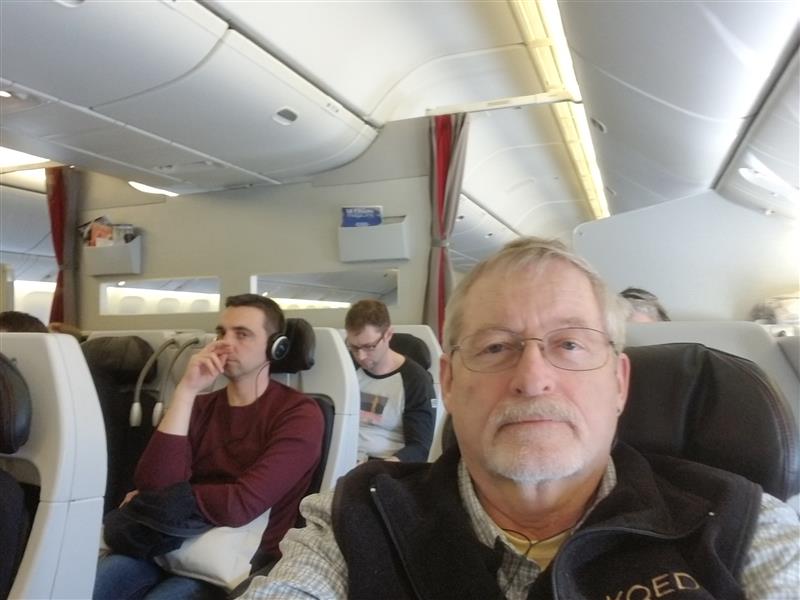
Tom in SFO just before take-off in a new Air France Boeing 777
We encountered snow and freezing temperatures when we changed planes in Paris. De-icing the plane added a little time in getting airborne on the last leg. The temperatures were in the low 70s when Tom left the Bay Area. He wasn't quite prepared for the cold!
This is what we saw when w changed planes in Paris.
(https://youtu.be/Wmw8JeWi-xo)
The real problem was that we arrived in Casablanca without our luggage. This posed a big problem because if we didn't get them this day, we wouldn't see a change of underwear for 3 or 4 more days and even that wasn't a certainty. Our travel organization met us and drove us to our hotel 20 plus miles away. This was a 1 ½ hour crawl in rush hour traffic. We arrived just in time for dinner at our hotel. We are near the harbor of Casablanca (the largest city in Morocco, founded by the French in 1912).
Youssef our guide called and found out our bags were at the airport. The problem was they don't deliver bags, it was getting very late and we had to PERSONALLY go back to the airport to fetch them. Our guide helped us hire a taxi and went with us to the airport where he had to stay outside. It seemed to take forever, but we did leave with our 3 bags!
We met up with the other four plus our guide Youssef to do a 5 day pre-tour. Tomorrow, the Blue City, northwest in the Rif Mountains.
Feb 6-8 - Chefchaouen
We awoke to a downpour from off the Atlantic this, morning, but our spirits were not dampened by as we set off on a 150-mile drive north toward the Rif Range of the Atlas Mountains. It began on a fairly new four lane toll road, part of the kingdom’s massive efforts to build/rebuild Morocco’s infrastructure. When the French left Morocco 60 years ago, there were only 100 miles of paved road in the country. Now there is a good highway system.
17 seat tour van ... our transportation for the pre-trip tour.
Elaine and Virginia patiently waiting while 3 SIM cards were installed in tourist's phones.
We stopped in a small town in the middle of beautiful agriculture country stretching from the mountains to the ocean. Since it is the rainy season, everything is verdant with crops of sugar cane, sugar beets, olive groves, orange trees, as well as lots of cattle and sheep.
Our guide arranged for us to have a typical Moroccan meal cooked in a traditional way. Tagines, clay pots with a conical lid are filled with meat and vegetable then placed over charcoal fires for several hours. There was meat hanging and the cook took down some beef, cubed it up, and put it through a grinder adding spices. These were shaped into small oblong meat balls placed on a hinged grate to put over the fire.
With that we had various kinds olives, lentils, lamb chops, and a wonderful traditional bread finished off with the sweetest oranges and a small variety of banana. It was cold in the 40’s, but we ate outside.
Barbequing beef and lamb at lunch restaurant. Vegetarian's delight is under terra cotta Moroccan Tagine
Vegetarian choices
Love the Moroccan bread.
Lamb and beef at barbeque restaurant. (Glad I'm a vegetarian.)
From there it was off to Chefchaouen ("chef-chown") nicknamed the Blue City since so many of the houses are painted blue. There are snow-covered mountains all around. We stopped at a view point just outside the city just as the sun came out making for fine photos.
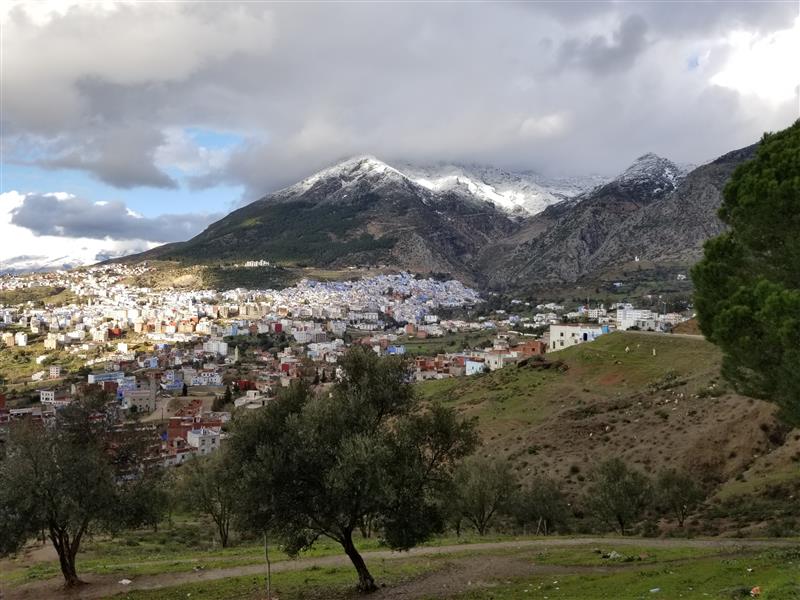
Tuesday's destination: Chefchaouen
Chefchaouen (the blue city)
We drove on into the city heading toward the old walled part. We had to leave our large van, have our suitcases loaded onto a small vehicle, and walk the rest of the way to our Riad, one of many inns developed from ancient houses. Ours is most charming. It has several floors with rooms opening on a courtyard formerly open to the weather. The artwork, mosaics and other crafts are really something. The rooms are comfortable and fun.
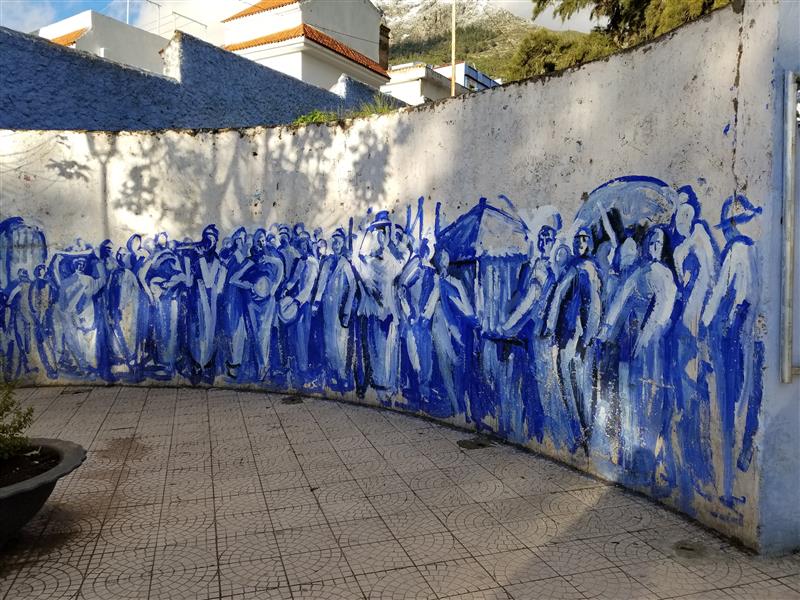
Painted wall in Chefchaouen
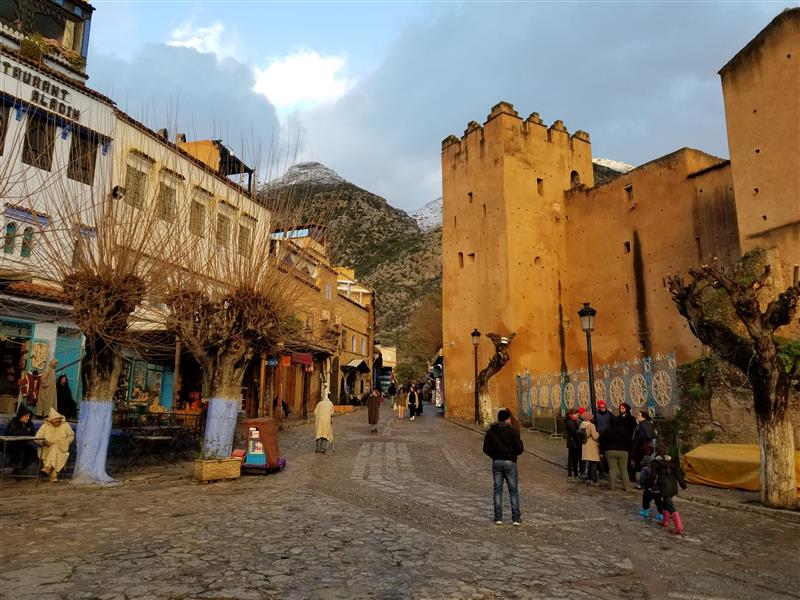
Our hotel is in the old part of the city
Town square: Elaine, Peter, Virginia, Tom, Randi and Laurie
Many men were wearing these long hooded robes - great for the cold weather.
Moroccan women walking in the town square
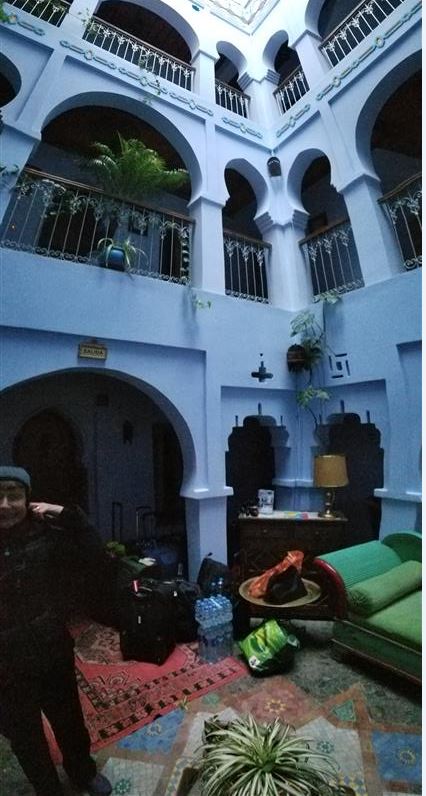
Courtyard of our hotel (Riad called the Casa Hassan Guesthouse)
A bedroom in the riad (typical Moroccan home with courtyard.)
For dinner with stepped outside our hotel and crossed the alleyway to the hotel's restaurant. We had a choice of very traditional entrée’s. We sat in a banquette which would be found in most Moroccan homes with lots of pillows. Other people, families are expected to drop in from time to time and you will have plenty of room for them to eat and then sleep on the benches.
We have learned much from our tour guide, and were especially surprised to learn that Morocco’s chief export is automobiles, the Dacia, made in a joint Nissan-Renault venture.
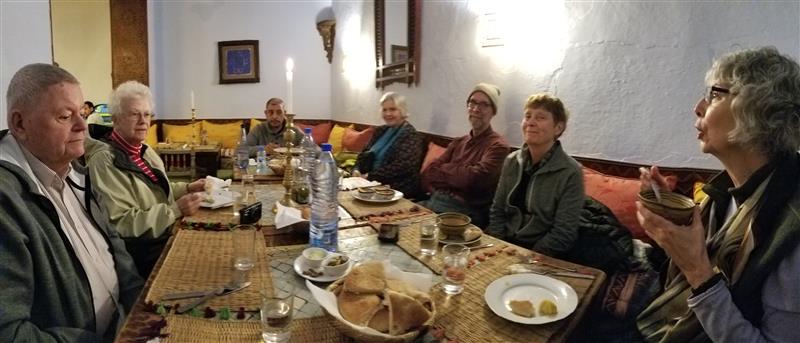
Dinner: Joel, Elaine, Youssef our guide, Virginia, Peter, Randi and Laurie
Dear Tom, Joel, and Elaine I hope you will make a nice trip and return home safe and sound. --- Tetsuya
Dear Tom, Elaine and Joel, Keep sending me your trip reports from Morocco. (I can always travel vicariously.) It looks like you're having a great time.
Greetings from Seville, Spain, just north of where you are. I am touring Granada, Seville and Toledo (while Richard works in the Admissions Office at the UO).
Today I leave for Madrid, where I fly back to Eugene on Friday. Safe journeys, Kim
Hi Tom, Have a great trip. Morocco is a favorite destination of mine. Had a Fulbright teaching exchange there many years ago and have stayed in contact with my host family in Tetouan.
A former student took me to Chefchaouen with his friends for dinner on my last visit. Fez is a favorite destination- just getting lost in the streets and having a scrubbing in a hammam. I am happy to see snow in the mountains in the photos you posted. I look forward to more commentary and photos.
Jon
Oh goody, more travel pictures and stories! Love, Nancy D.
Interesting, Tom. Thanks for sending me all the pictures. Enjoy your trip - Fred K.
WOW>>>>>some wonderful photos Tom!!!!!!!! --Thank you for sharing! -- Janek and Carl
Hi - Thank you for sharing your trip with us. We get to read and see where you have been. Have a safe and enjoyable trip. Aloha Douglas and SharleneEverything looks very nice. Hope the hotel is heated….. I remember waiting for the SIM card (should have got one myself). -- Terry
Terrific. I have friends who keep second/third homes in the old quarter of Marrakesh. They’ve been going to Morocco for decades and love the place. I visited once, and keep flirting with the idea to go back.
Best to you all and have fun. The food can be quite wonderful, and the Arab hospitality is second to none. --Mick --
Thanks for sharing your adventure - Joel seems to look a little dubious at the dinner table! -- Almeta
Thanks Tom, always enjoy your trip accounts. -- Molly
Love it, looks like such fun. --- Tom S.
Hello Tom, What a great trip you all are having in Morocco. Once again your descriptions are vividly exciting ans do capture the marvels of the unique places. The foods seem ti make each place different and your vegetarian needs are not a problem.
The Blue city is truly a one off a kind
experience. - Dick P
Love your travel adventures. The hotel courtyard style is so much like the one we had in Fez. It's much appreciated airiness in crowded cities like Fez, where we had to flatten ourselves against the walls of the very narrow pedestrian streets when the heavily laden donkeys came past.
Look for the people with the green or turquoise eyes. Amazing! - Pam and Larry
Fascinating and quite beautiful. Keep ‘em coming. And keep having a great time! Hugs Ruth
Thanks so much for the lovely travelog ..Keep em coming -- Cheryl
Amazing! Thank you for including us on your travels!! --- Mary and Ginger
(If you want to be removed from the e-mailing list, no problem --- please let me know. ... tom) |
Here is the missing video of Paris snowing:
We are "back in the saddle" with production of our travel journal. Tom uses his website, selects pictures, and writes captions. Joel is sure he looks for some that our the most unflattering. Joel writes most of the narrative replete with lies and half-truths. He is apt to fall asleep when the leader imparts information. No problem, just make something up, no one will know the difference. Fortunately Tom, who took the notes can catch and correct it. Elaine is the eagle-eyed editor, but we have to work so fast that she often doesn’t get time to do it justice.
Chefchaouen - Continued
We awoke early, some of us early enough to hear the call to prayer at dawn. (5:40) We’re not seeing much daylight yet in this valley, but it must be somewhere. We are across from the Casbah (fort) and the main mosque. I asked our leader a bit about the mosques which we have seen at the center of all the villages we passed. There would be a number in this small city of 43,000 and hundreds in Casablanca. I was wondering how they are supported and if people belong to one. He said that they are built and supported by the state and that there is a clergy that is or will soon required to study for an advanced degree before they are allowed to preach. No one is allowed to build one outside the state. I gathered that these measures were a counter to the Islamic fundamentalism that shouts the loudest and often appears to speak for them all.
Joel and Tom on morning city hike
Our guide, who is Muslim, will speak about this much more in future days, but already we have the impression that he is resentful toward Saudi Arabia’s control of the faith.
We are learning that many Moroccans take a very tolerant view of things condemned by Islam. Our guide made a stop at a store to buy alcohol for any of us who wanted. One fellow traveler got some wine and wanted to take it to dinner. The restaurant said fine, as long as you keep it mostly out of sight. Youssef said that he thought more beer was consumed in Morocco than France. The only thing really prohibited is cannabis and hash and the fines are strict. We were warned that we would be approached in this city since it is grown nearby.
Tom and Laurie
It is cold this morning and Tom was NOT prepared. The night before, Youssef took him out to buy some modern top and bottom long-johns (thin material). Now Tom is not cold.
Our guide took us out on a morning walk through the medina (walled city) to the souk (market) that lines the narrow steep streets which were sometimes stairs.
Flowers will be blooming on these walls in the Spring.
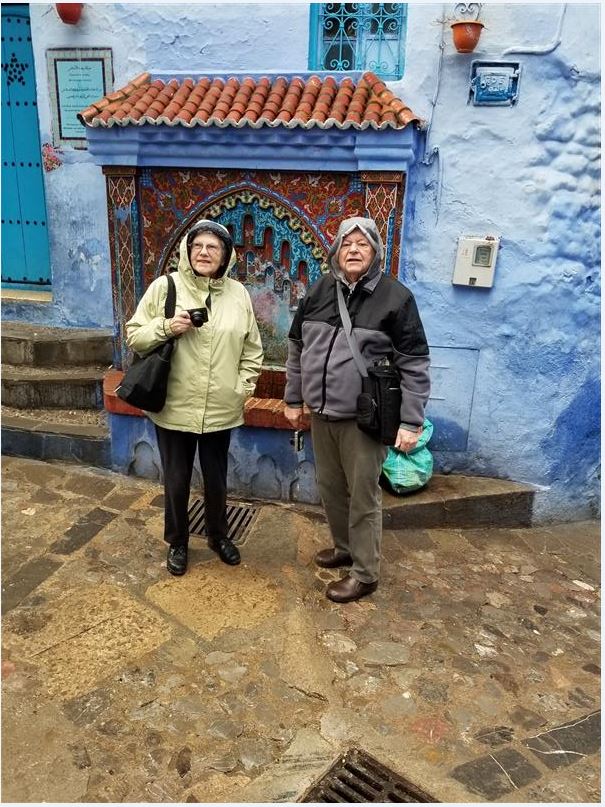
Elaine and Joel in front of neighborhood water source (at one time.)
Since it is cold, most all men are wearing a long woolen garment with an attached pointy hood. They go almost to the ground. Most of the youth don’t wear them. Everyone looks trim and fit no doubt because no cars are allowed on the narrow streets which can be very steep. Lots of exercise.
Selling vintage caftans ... vendor is from Harry Potter!
Of particular note was a community bakery where the man would build a fire to heat the shared oven. Then the women would bring the round and flat loaves of bread to be slid into the oven. They only took a short time to bake. They might use the oven 2 or 3 times a week. We were able to sample some of it.
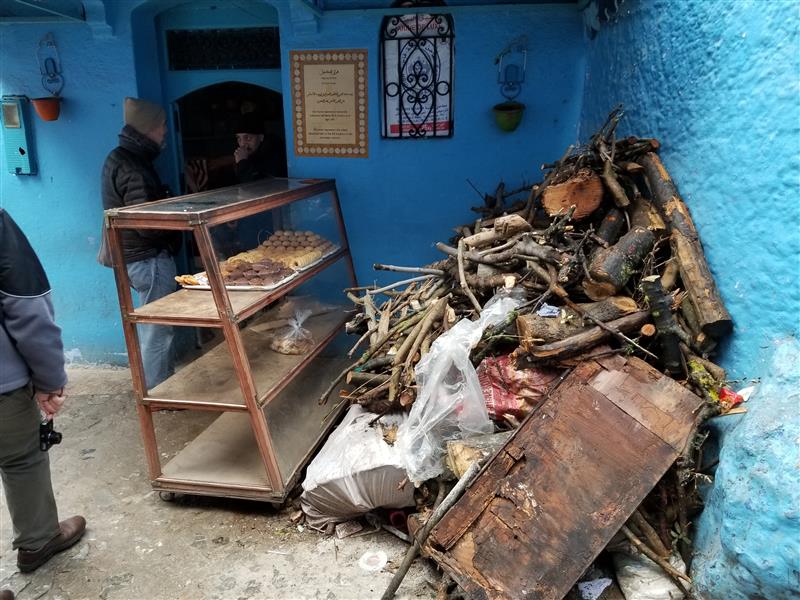
Neighborhood cooperative oven.
Bring your raised dough and he will bake it in shared oven
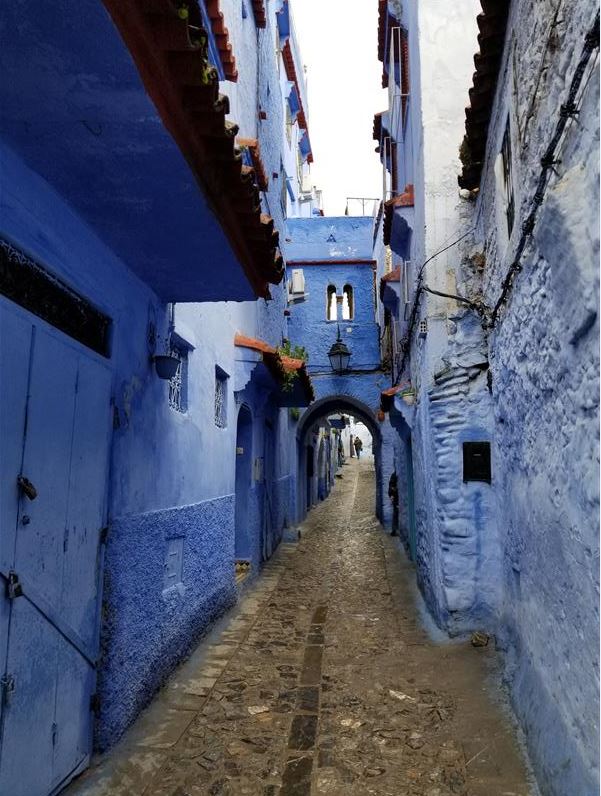
Main street of old town
Uneated bread is left out for the animals.
Upper "street"
Our guide pushed us on up the alley to a source where water gushes out of the ground from a spring.
Fruit, figs, olives, etc for sale
Dried figs, olives and beans.
Muslim burial yard behind wall
Snow in the nearby Rif Mountains
Back down in the public square, we boarded our van to drive 45 mins. out to a mountain village of about 60 families to visit a farm family. To promote better understanding our travel company hires this family: a father, mother, and 1 ½ yr old child aided by two sisters-in-law.
Ready for lunch at farmer's home-hosted lunch
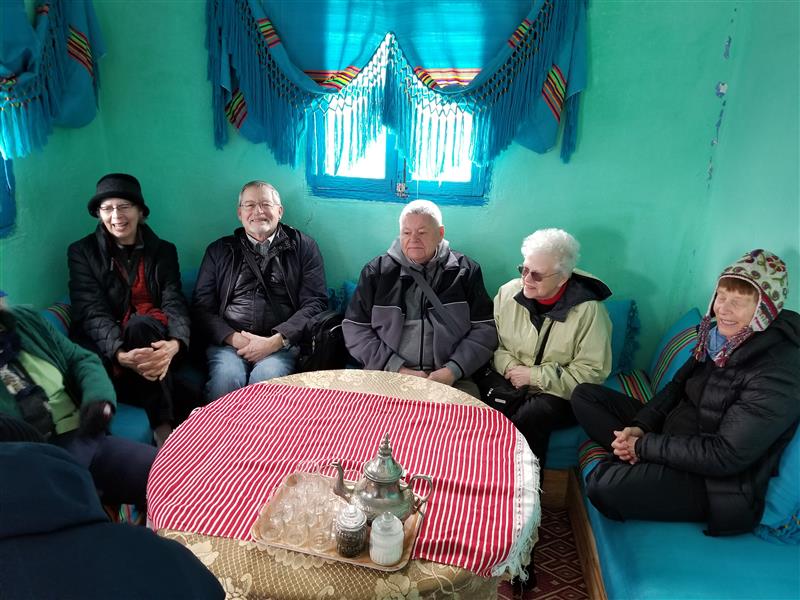
Laurie, Tom, Joel, Elaine and Randi getting ready for tea
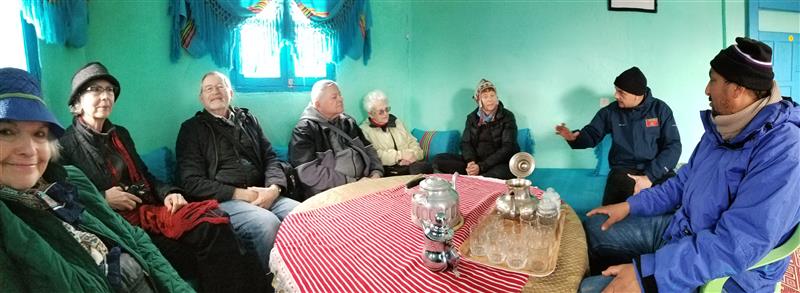
Virginia, Laurie, Tom, Joel, Elaine and Randi, Youssef served tea by Mohammed
We had a great time first having the traditional black tea with mint and sugar: 1 tablespoon sugar in the pot for us instead of the usual 7 at our request. The father demonstrated making the tea and we drank it with cookies.
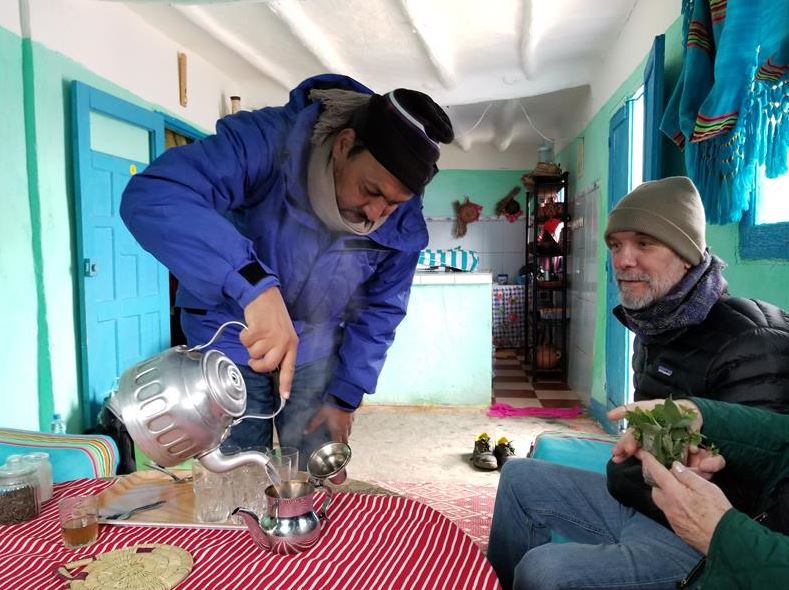
Mohammed pouring black tea with sugar and fresh mint leaves
We were invited to help with the cooking, some peeling turnips for the vegetable tajine, and others helping bake the bread.
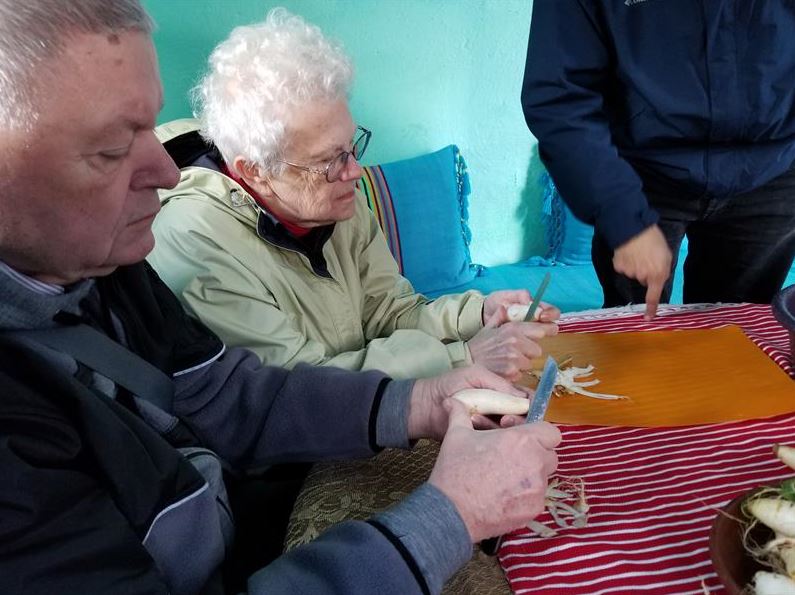
Peeling Turnips!
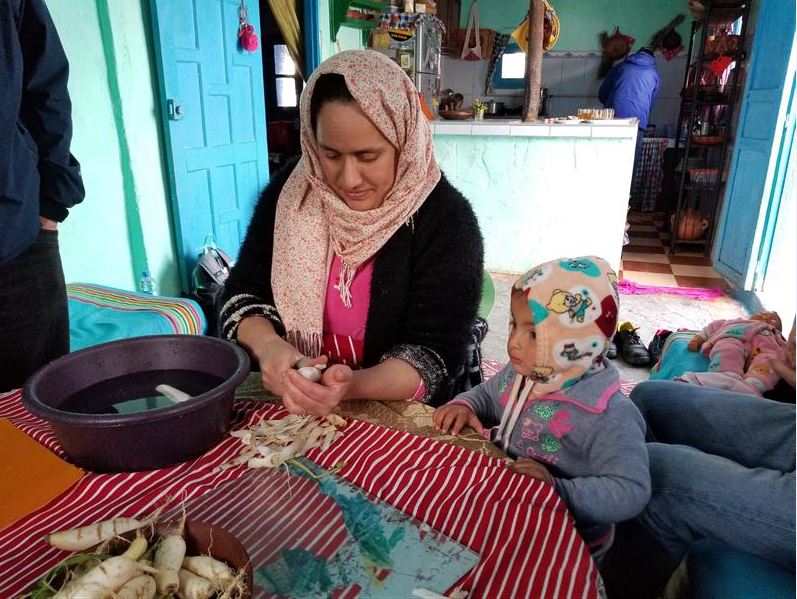
Mohammed's wife and daughter Zena getting turnips ready for the tagine.
There was an oven outside where a fire had been built and all was ready. We were able to watch one of the women slide the loaves in which had been proofing in the kitchen. They were made with barley and were so good right out of the oven.
Soon the rest of the meal was ready.
Bread dough ready for baking
Bread goes in outside, domed clay oven with terra cotta tile floor
First course was cauliflower and cabbage which had been steamed then dipped in egg and fried. Delicious! Next came the fava bean soup with a dash of the farm’s olive oil. Our guide explained that unlike the extra-virgin oil we usually get, they let the red and black olives ripen and fall onto a plastic ground cloth before squeezing out the oil. This type keeps better in the hot weather. 3rd course was a chicken tagine with peas and carrots and the turnips which were especially good with spices including saffron. We finished with fruit and were then on our way back to the Blue City.
Cooking cauliflower
Cauliflower and cabbage
Chicken, peas and carrots (turnips in background)
Some of the group visited the Casbah and Joel stopped to get a sim card for his phone.
At 6PM, Fatima came and talked to our group in a lobby area (between a fireplace and a propane heater). She and Youssef talked about changes that the current king and parliment have made to improve the status of women here.
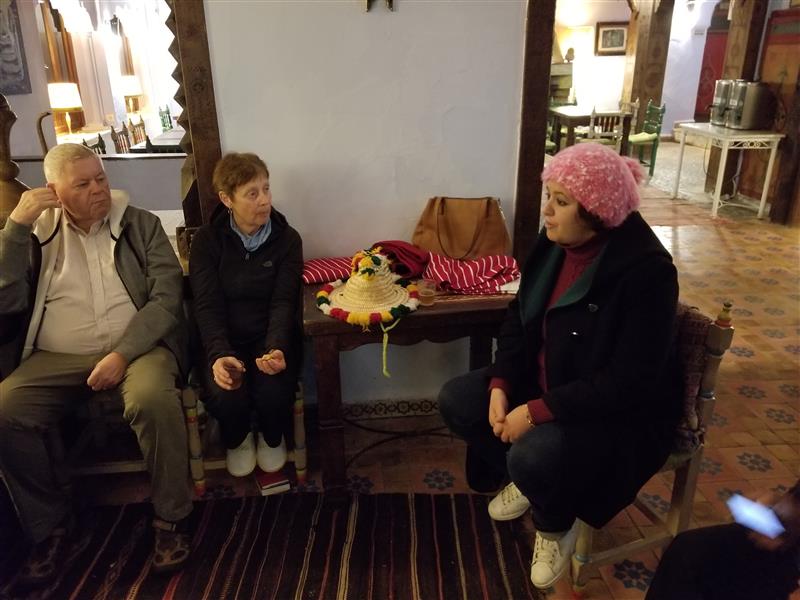
Fatima's evening presentation about the status of women in modern Morocco.
Dinner was on our own and several of us went to a nearby restaurant and had soup, omelets and more bread. This modest dinner cost us about $1.50 each.
Sure enjoyed tracking you! next best thing than going. Out and about ... Don N.
Tom, Thank you for sending all the interesting photos and story, Fatimah and I love to know more about your trip. by the look at your photo it is cold there and the food look delicious, are they spicy? Send me more story and photos. Fred & Fatimah
Wow, what a wonderful adventure! Thanks for sharing. --- Ruth K
Eat more dates!!! -- Jeanne H
Glad you are having a great experience. I know hash is often sold along the highway through the mountains as a cash crop.
The food looks inviting and reminds me of meals there. Morocco does not take its orders from Saudia Arabia, grace a Dieu. Also, Moroccan Arabic is a different from classic Arabic. So many interesting and fascinating things. I was never there during cold weather, but I did return with a Moroccan wardrobe including the country djellaba, formal refined djellaba, various hats and yellow babouches like the king wears. If you ever need to dress as a Moroccan, just let me know. Have fun. ---Jon
Tom & Co. - Thank you for including us in your travel adventures! A dear friend of mine and her husband traveled to Morocco last year and had a grand time - loved the food and the colorful people and architecture. We are already looking for your next "installment" of your journey. Thank you again so very much. Is Elaine going to look for some yarn? Just wondering... Jimmy and Glenda
The photos are gorgeous. Love the script as well. Never thought about going to Casablanca or surrounding areas. Thanks for sending--- Carol S.
Dear Tom, thank you for sending your journey's photo- diary. I utterly enjoy it, especially because two of our boys were already in Marocco and I had a glimpse of their adventures. From our warm sofa this is a great way of traveling! Greetings to the trip-members I know - and thank You! Your Ap.
Entrance to Tom's Room at Riad Hassan
Joel and Elaine in the room below
Tour guide Youssef in traditional
hooded djellaba
Today we left early for an overland drive to the UNESCO world heritage site of Tetouan. Our drive began with a drive through the Rif Mountains northwest to the Mediterranean Sea.
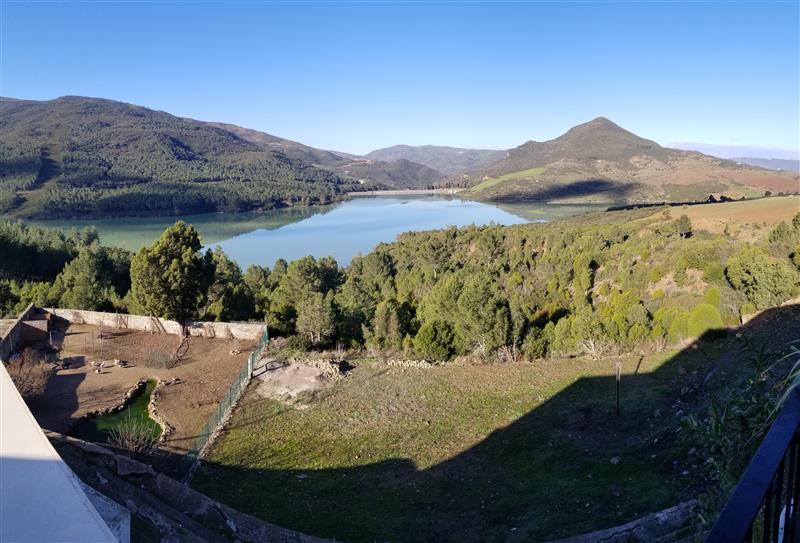
One of Morocco's many dams on our way to seaside city of Tetouan
The city is a rich mix of cultures and traditions of the Romans, Andalusian and European. Inside the city walls is a thriving market with Jewish and Muslim sections seemingly unchanged from the founding in the 15th century by Andalusian refugees from Spain.

Drop off point in Tetouan to start city walking tour
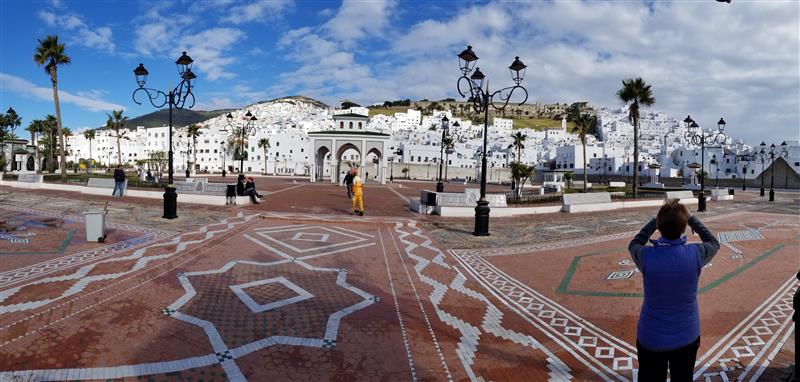
Tetouan modern square below old royal palace (high on the hill)
We spent several hours winding through the narrow streets looking at all the small shops containing anything one would ever need. Tempting were the candies, fruits and nuts given out in samples to the passersby.
Paving sidewalk with granite cobble stones
Beautiful traditional "Horseshoe" arch
Dacia utility van built in Morocco and exported world-wide
Decorative fountain near Medina (old walled city)
Tints and colors at a paint shop
We were soon joined by a young man who is a type of policemen sponsored by the city and responsible for making sure our group passes through with no problems. He was there not so much to police us, but to make sure that we weren’t victims of petty crime.
Youssef and helpful tourist policeman
Tom in souk (bazaar) in Tetouan Medina
Cheeses (goat and cow milk) and dates and dried fruits
Vegetables and a display of olives
in souk
We emerged from the shopping and crossed the street to a school run for high school aged kids to learn the handcrafts of Morocco. Woodworking, metalcraft, embroidering, painting, etc. were the subjects taught to prepare boys and girls for jobs in the industry.
Painting on wood and carving wood
at art/craft school in Tetouan
Macrame and embroidery (with Virginia in yellow/green)
After boarding the bus and taking a short drive to the fishing village of Asiz, we lunched at a large, modern seafood restaurant. You could, if you wanted, choose your fish from a large display case. There were large windows overlooking the sea.
Salads and fresh fish at Marisco Restaurant in Tetouan
Laurie, Randi, Virginia, Tom, Joel and Pete at Tetouan seaside restaurant
The ride back was another route along the coast and then inland through the mountain to our last night in the Blue City.
Beautiful and very interesting. --- Almeta
Love the architecture. It seems so warm and human-friendly. Also was wishing I could fill my pantry with those luscious looking dates and figs!! Yummy. Keep ‘em coming and thanks. Hugs Ruth
Beautiful! Love the old architecture...Thanks! -- Cheryl
Fabulous! Miss you -- --- Max C
Thanks for sharing. I am really enjoying the pictures. Looks like you are having a great time. -- Gladys G
Tom Bastila- the pigeon pie. Be sure to order or share an entire one with Joel, Elaine and friends. It takes a long time to prepare when making it from scratch, but worth the effort.
Glad you enjoyed Tetouan. -- Jon S
While at the market, did any of you (3) buy cheese, dates/dried fruit or olives? They look so delicious. --- Linda
Great pictures and naration. I was so impressed with Morocco during my last trip here last September. Wait till you visit the Marakesh medina – it’s huge!
No mention of a visit to Rick’s Café in Casablanca? -- Jon H
Soo beautiful. The photos are outstanding. I know I might have asked in the past, but what kind of camera are you using? Carol S.
Hello Tom, What a marvelous trip you all are experiencing. I know nothing about the country and your photo’s and writings have made it come alive for me. The Blue City as an urban environment have captured the unique and specialness of your travels. Thank you so much for including me your adventure. Best, Dick PS - I’d love a hooded djellaba!!!
Thank you, Tom, it seems to be very nice in Marocco. Have a good trip. Best regards Urs
Bright sunshine greeted us as we set out from our Riad and hiked downhill to find our bus and faithful driver. Late of an evening, all the shops are going strong, but they are slow to get started in the morning. The city has done an excellent job of repaving all the alleyways to look old, be stable and give traction.
Our route today takes us up to the northwest tip of Morocco to the cosmopolitan city of Tangier on the eastern edge of the Straits of Gibraltar.
Joel, Elaine, Virginia departing the Riad Hassan in
Chefchaouen
On the way we stopped for a coffee break near Fnideq overlooking the beautiful blue Mediterranean. We could look over to a rocky peninsula that contains the Spanish city of Cueta. It is a Spanish enclave with an international border that appears to be a bone of contention for the Moroccans. It is a gateway for contraband products flooding Morocco tax free, and a place for immigrants to get into Europe. We understand that the status of these cities (and there are several) is in the World Court and UN, and Morocco prefers to see it resolved there.
Tom and Joel taking a mint tea/coffee break
near Fnideq on the Mediterranean Sea
Ceuta, an 18.5-square-km Spanish autonomous city in Morocco, in the distance
There are forests near this area and immigrants hide out there until they can get across. Our guide said that one of the films used in the US election supposedly showing dozens of immigrants climbing a fence claimed they were coming from Mexico. Moroccans knew better as they recognized the place.
When we boarded our van this morning, the driver had a large bag of baguettes. We didn’t think much about why he had them, but he knew that immigrants would be standing by the highway hoping for some water and food. It was his religious and humanitarian duty to have something for those in need. He stopped and gave the bread to the first ones he saw, and another place he handed out a bottle of water.
Elaine in Fnideq with Mosque in the background
When we got a little farther west, we could look across and see the Rock of Gibraltar from the southern side. It is still some distance to the Atlantic Ocean. Just to the left of this next photo, the Moroccans have built a huge modern port to ship goods from Africa and receive containers from elsewhere. It is amazing. There are new rail lines and work is in progress for a bullet train to the capital of Rabat and eventually south to Marrakesh,
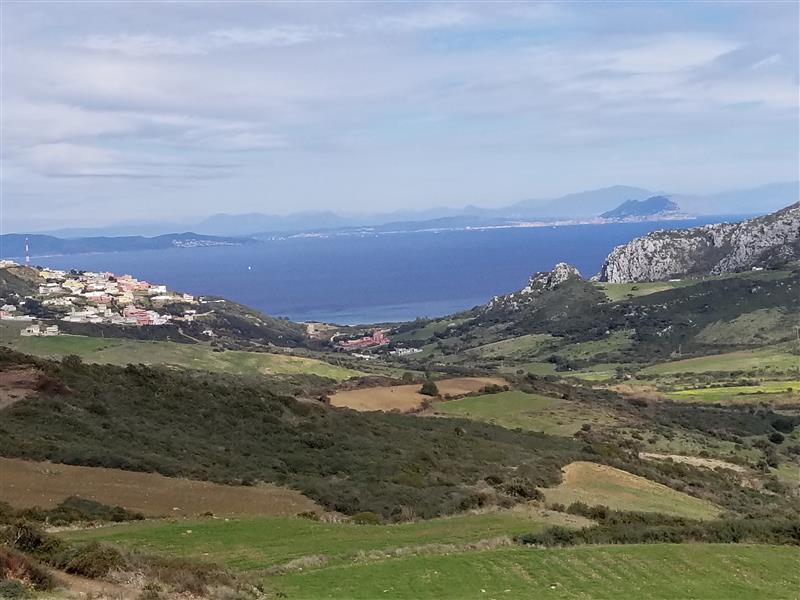
Rock of Gibraltar (black) and Spain in the distance ... across from Morocco
We have been hearing a lot about King Mohammed VI, who has been a very transformative figure in modernizing the country. The northern part had been like a lawless frontier rarely visited by the former king. Mohammed VI, immediately came north and built a residence signaling his desire to bring that population more into the fold.
Close-up of Rock of Gibraltar from Morocco
By lunchtime we reached Tangier, a city of about 1 million on the Atlantic just across from Spain. During the time the French colonized Morocco, Tangier was treated as an international city, favorite of artists and writers with a very diverse population.
In WWII, Morocco was under the control of the Vichy French, but Tangier was a gray area where the Americans ran an intelligence operation. Lunch was in a Lebanese restaurant called Ali Baba, overlooking the water.
Mediterranean plate: pita, falafel, stuffed grape leaves, tabouli salad: lunch in Tangier
Lighthouse at Cape Spartel in Tangier
Elaine with young donkey and its Berber trainer
Making the donkey "smile"
Joel ready to see the Caves where Hercules rested during his labors. The opening is in the shape of Africa.
Tom and Randi and veiled woman looking out to sea.
Caves where Hercules where the opening is in the shape of Africa.
We walked into the limestone cave where for years, round mill stones were cut out of the walls. Imbedded in the rock are fossils of sea creatures and our special guide of this place said that calcium and minerals were added to the flour in the grinding process. There is a large opening out to the ocean in the shape of Africa including Madagascar, but from the inside it was reversed. The chambers of the cave supposedly represent the world: but this narrative was unfortunately lost on most of us.
After a stroll through a part of the medina of the city, we were ready to go to our hotel for some ten toes up before meeting for dinner.
Youssef, guide, Tom and Laurie in the caves.
Old building near the medina in Tangier
View of marina and port from our Tangier Hotel
Room in Tangier hotel
'Have been fascinated and completely won over this week while reading your description of Morocco -- so much so that I think it will be my next travel destination. Oh wait......I just saw your photo of where you stopped for coffee. Apparently, there are no Starbucks there.
So never mind. lol. -- Larry
Thanks again. Am forwarding them to 11 people who seem quite enchanted with your adventures. -- Ruth
Hi Tom & everyone! Yes, the emails are coming through just fine. Thank you so much! The photos are lovely! I wish I were there! --Lisa L
Today we could sleep in since we were going to go to visit the museum at the restored American Legation in Tangier before we began our drive to the Moroccan capital of Rabat.
The weather has turned warmer and we are comfortable outside without so many layers.
Tom and Joel in Breakfast room at our Tangier hotel - harbor and marina outside the window.
The view of the harbor from our hotel. There has been lots of redevelopment of this area in the last few years. The ferry terminal is in the background.
Marina and ferry terminal in Tangier
Tangier bay and esplanade from our hotel
Virginia, Youssef, Joel, Tom and Randi at American Legation in Tangier
In 1976, a group of Americans donated money to undertake the renovation of the American Legation in Tangier. We learned that Morocco had been the first nation to recognize the independence of the American colonies in 1777 continuing a special relationship between the two countries. After the American Civil War, the Sultan contacted the American representative proposing that America make Morocco a protectorate since he feared that England, France or Germany were poised to do the same. America, immersed in reconstruction, declined.
Pete, Elaine, Virginia and Tom in American Legation in Tangier
Tom in Tangier
Elaine in American Legation in Tangier
Inner courtyard of American Legation in Tangier
Tile showing Moroccan and American flags/cooperation
Ladies room door décor
Paul Bowles at opening night of his play/musical in Tangier
Paul Frederic Bowles was an American expatriate composer, author, and translator. He became associated with Tangier, where he settled in 1947 and lived for 52 years to the end of his life in 1999. The special exhibit of his life and work helps explain the allure Tangier had for Americans at on time or another.
Paul Bowles
... Truman Capote, Jane Bowles and Paul Bowles 1949
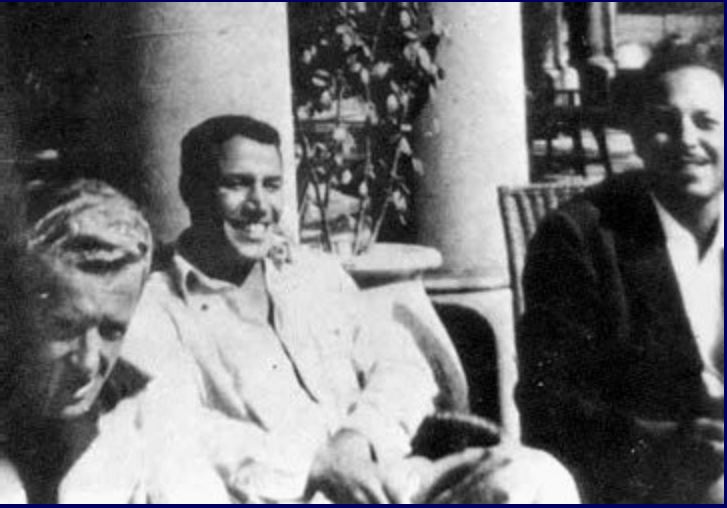
Paul Bowles, Ahmed Yacoubi and Tennessee Williams, 1954
Leaving Tangier after an all to brief visit, we drove on the modern toll road for the 4-hour drive to Rabat. Most of the way is an agricultural plain with miles and miles of plastic greenhouse production. For a long ways, the plastic covered bananas for wintertime production.
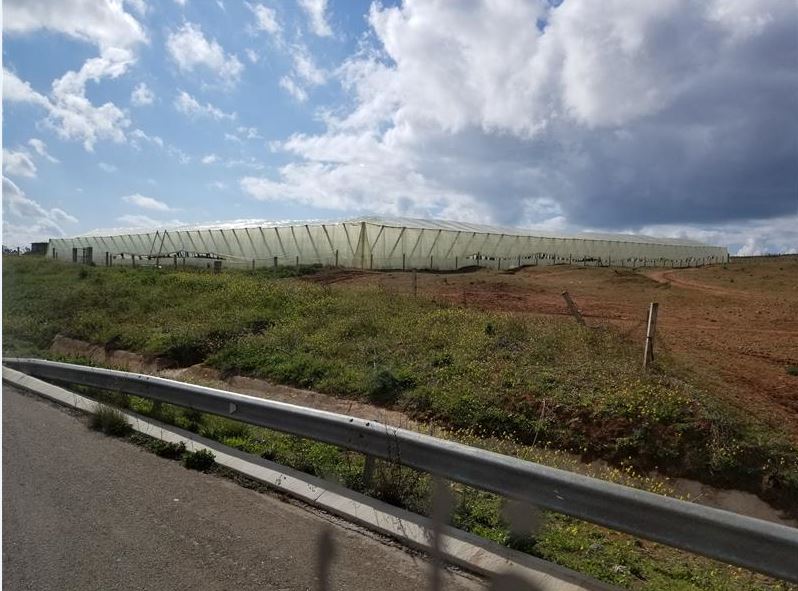
Miles and miles of greenhouses like these.
For rest stops, we pulled into La Afrique, a chain for refueling and buying fresh food cooked to order. Our hotel is situated in the center of the new city near museums, government buildings, banking, and commerce. We are impressed.
At the end of dinner, the lights in the restaurant went out and we thought they were having power problems. Instead they brought out a birthday cake to celebrate Elaine's Birthday!
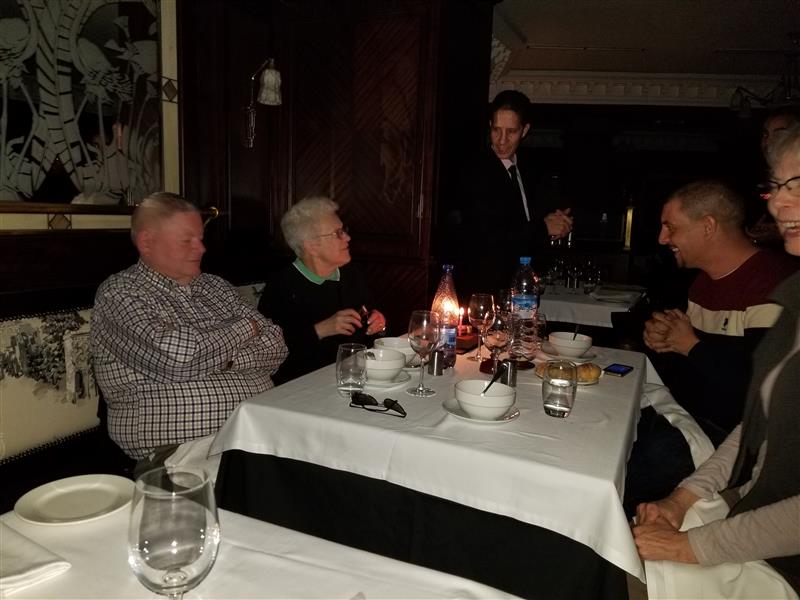
Joel, Elaine, waiter, Youssef and Laurie: Surprise Happy Birthday for Elaine
One thing we are not used to is the smell of cigarette smoke. There are non-smoking areas, but it seems it's only if the restaurants want to do provide it.
Happy birthday Elaine! I took the ferry from Tangier to Spain and passed Gibraltar. It was fascinating. No Prudential sign in sight. Have fun in Rabat. Jon S
Loving your photos. Morocco definitively on our travel bucket list. Rob J.
Fascinating to see the young creative folk who had been there ... Capote, et al. Happy birthday Elaine! -- Ruth
Happy Birthday to Elaine! Thirty-five again?!? I enjoyed seeing the historical photos of ex-pat American writers and playwrights in Morocco. In my recent travels to Spain, I found, too, that the movement toward smoke-free public spaces had passed Spain by. Safe journeys,-- KIM
OHH. HAPPY HAPPY BIRTHDAY ELAINE! -- Cheryl
Obviously more modern than your last postings. The beautiful colorful buildings were a joy to see. -- Carol S
Hi Tom,I read [your blog] all and loved it. I was kind of sad at the abrupt end, so thanks for the warning. I love your photos and fun descriptions! I did that trip 2 years ago (I did the main and post trip to Essoara). I was there in an extra hot May, so a different experience. I am especially enjoying re-living the food (mostly the bread). Wow, it just keeps getting better every day! Have fun and thanks so much for including me. I forwarded to my friend Sue (Virginia knows her). She also did the trip years ago.
Have fun and keep your wonderful travel blog going for those of us who wish we were there but sadly have to work.
Thanks again for keeping me up to date on my mom, Virginia's daughter Nora
Yesterday afternoon we reached the costal capital city of Rabat, a city of about 55o,ooo and a metropolitan population of about 1.5 million. It is a gleaming modern city with wide boulevards, government buildings, the parliament and palace.
Our Rabat Hotel: MGallery by Sofitel
Joel preparing a laundry order
Royal Palace in Rabat
We were out in good time this morning to visit the palace compound. King Mohammad VI upon his ascendancy kicked out all his relatives and moved out himself to his own housing. When his father Hassan II traveled, there was a retinue of 1,000’s, but that it no more. Mohammad VI drives his own car. Formerly, the people knew nothing about the king’s wives; now she and her family are well known to the public. She is a commoner, a computer engineer, and they met at university.
Royal Palace Entrance
Entrance to Chellah a 14th century necropolis – Roman Ruins
Tree with large, pink cluster-blossoms
Roman Ruins
Storks sunning in tree tops
The storks, wintering from Europe, were everywhere in this place. There was the constant clacking of stork’s bills.
Nesting storks
Tom at Roman Ruins
Sue, Kathy, Vicki and Youssef in ancient mosque
Remains of ancient mosque school
Joel entering Rabat Casbah (fortified compound)

Joel taking photos of panorama of Rabat coastline
Where the river meets the Atlantic Ocean. Lots of beaches and people surfing and fishing.
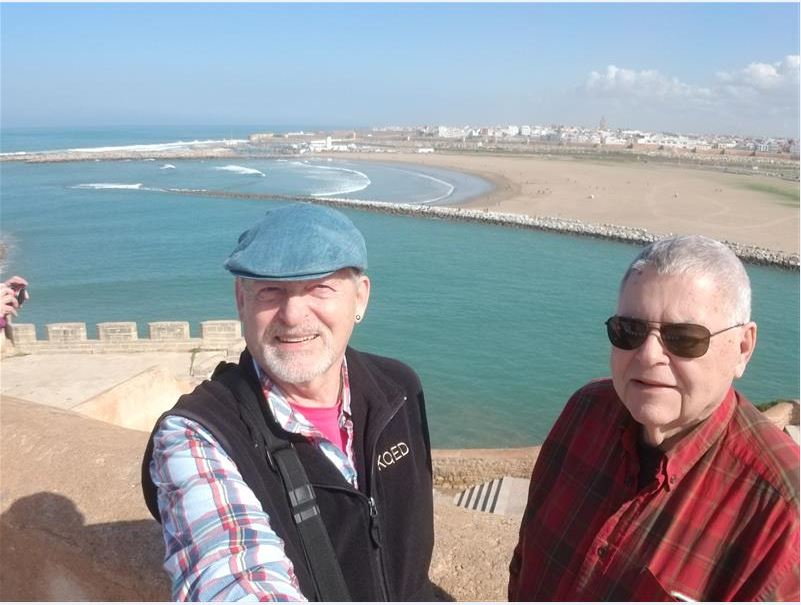
Tom and Joel at the Casbah
Elaine in the Antilucian gardens of the Casbah.
Tom, Elaine and Joel at the Royal mausoleum
Tomb of King Mohammed V and Hassan II
This was built in the 1960’s and 1970’s for Mohammed V, the King who led Morocco to freedom from the French. It was designed by a Vietnamese architect.
Joel, (really tall) royal guard, Tom and Elaine just outside of the royal mausoleum.
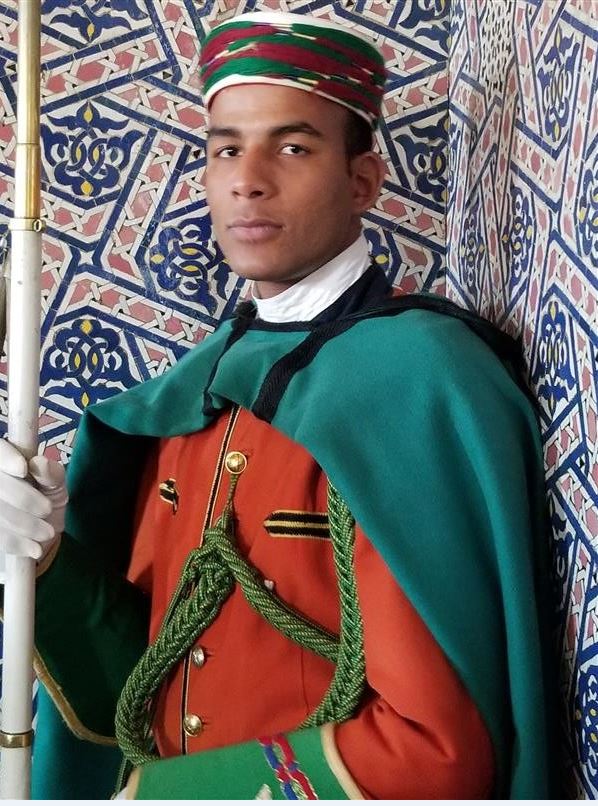
Royal guard at the tomb building
Elaine and Joel at royal mausoleum complex
This complex was to be the largest mosque in the world and was built mostly in the 1100's but not finished.
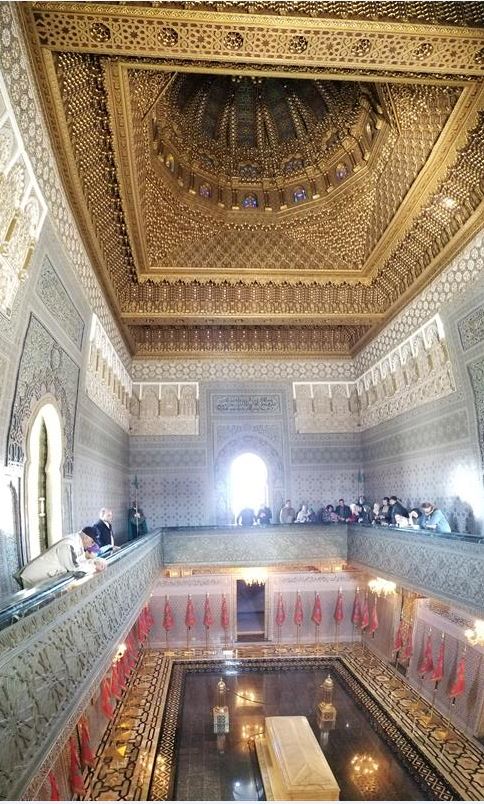
Burial places inside of tomb bui8lding
Grocery section of super market
Shopping cart inside of super market
Selling snails in broth on the street in the medina (old town).
Joel eating snails!
Even Virginia ate some snails
Laurie too
Tonight was our "welcome" dinner at this Riat Restaurant (riat meaning an old residence was converted into a restaurant). This is the first dinner where the pre-trip group joined the main trip group.
Main course: peppers and tomatoes stuffed with ground beef and rice
Tables for our OAT group
at a restaurant called Dinarjat at the end of a maze of tiny alleys in the Medina of Rabat.
Tom, Both Api and I really enjoy your travelogue emails. So good of you to share all these lovely and fascinating impressions of somewhere I will never go and know fairly little about. I find myself hoping you don't come home too soon and deprive me of my daily "Travels with Tom". Warm greetings to you and Joel and Elaine. Sarah
Great photos of Rabat. I was told this is the city to visit along with Fez and Marrakech. Our ship only stopped in Casablanca and Agadir. .
We had lunch at a famous hotel in Casablanca, LaMamounia. I was told by a friend about this famous hotel and the cab driver took us there( we thought.) Harry tried to find it when his ship stopped in Casablanca but to know avail. Apparently, the real hotel is located in Marrakech. If you hear otherwise, please let me know if your guide has any information about this mystery. That hotel in Casablanca was absolutely beautiful just like I imagined from the movies. Thanks again for another great tour of an area as seen through your eyes. Looking for the rest of your trip memories. Are you coming for lunch at Fromm before the semester ends? Rosemary J
There are never too many photos! photos...and I especially liked the grocery section. Haven't seen a red tomato here in months. AND, the stuffed peppers plate. Wow. Good to see you are having some fun. Sandra (H) D
Nice visit. Thanks. Tasty and colorful food continues. Blue sky. Jon S
Street Cats of Rabat
Our group left Rabat this morning for a bus ride of several hours to the city of Fez. (This is the spelling preferred by the French. The Moroccans use Fes and us Fez to refer to the red hat worn by Moroccan men for formal wear. We drove through the bread basket of Morocco. Many orchards, vineyards, and row crops. Often we would see sheep with shepherds, some grazing in the strip along the divided highway.
Grove of cork oak trees on the eastern outskirts of Rabat
Cork oak trees
Arabic stop sign
Banana stall of produce market (on way to Fez)
When we stopped for a coffee/restroom break, Youssef divided us into groups, gave us 50 Dirhams ($5). He asked us to go to the market across the street and bargain for fruit for our next breakfasts. The asking price was so reasonable that it was hard to suggest it be less. Adding to the fun/frustration was that no one spoke English. School French was a help. We ended up with some bananas, apples, tangerines, and pears. Even some avocados and a pinapple.
Fresh eggs
We are staying at another Riad, a converted family residence (inside a medina) which is a UNESCO world heritage site inside the city walls. The streets are narrow and buses and cars can only go so far. These gentlemen were waiting to transfer our luggage.
Transferring luggage to take to our riad ("inn" in medina (old city) in Fez
When we arrived at the Riad, we were greeted by a family member. He explained that large extended family owned and lived in two houses until the 1990’s when many in the family had moved away. It was decided to convert one of the buildings into a hotel. This meant a lot of renovation which had to be carefully carried out in compliance because it's in a UNESCO world heritage site. All the bedrooms open onto the main courtyard on the four levels. Originally this courtyard would have been open to the weather, but now have transparent roofs
Pete, Laurie, Joel, Kelly and Randy in couryard of our riad in Fez
Joel and Elaine's room in Fez
Elaine's bathroom
Looking down into interior courtyard in our riad
Interior courtyard
Door to Tom's room! Colored glass panels, close to breakfast room!

Tom's room in Fez
When it was time for lunch, it was served to us in the courtyard of the Riad.
Moroccan salad for lunch: tomatoes, carrots, potatoes, rice, beets, onions, olives, etc.
Seasoned ground beef with egg (l) and omlet with vegetables (r)
We were joined by a city guide who took us to a fortress on a high hill overlooking Fez. The tall square towers are all minarets of the mosques. The city lies in a valley surrounded by higher hills and mountains in the distance.
Medina in Fez
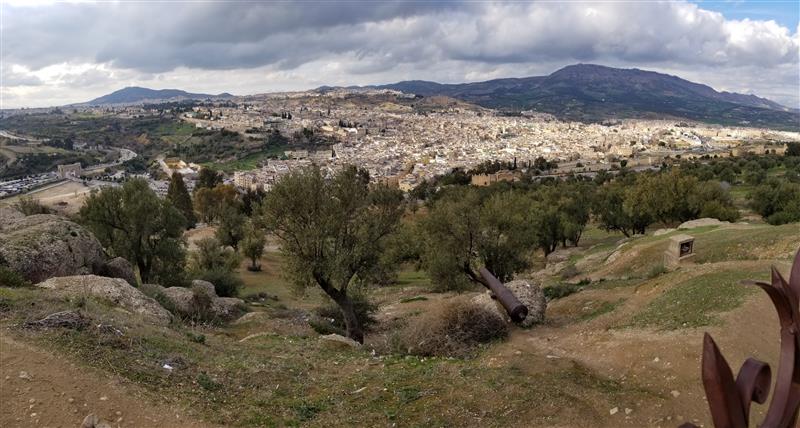
Wide angle view of medina in Fez
Making pottery items
Putting mosaic together ("good" side down)
Pottery for sale
Mosaic tables and fountains, etc.
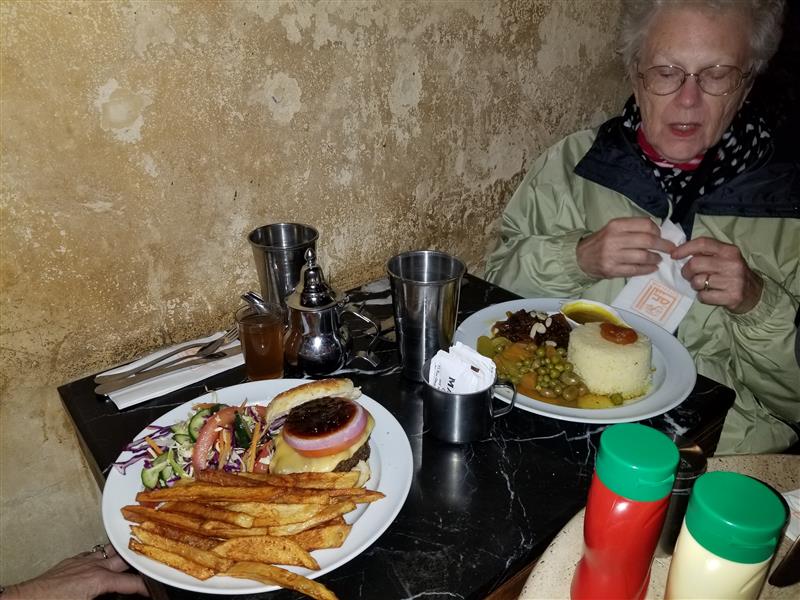
Dinner tonight at Clock Cafe - camel burger (left), Elaine's vegetable couscous (right)
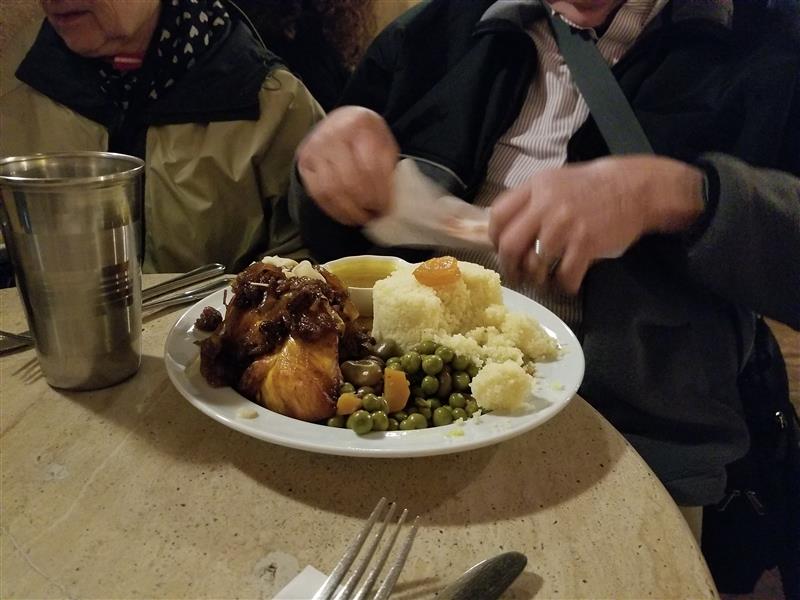
Joel's chicken couscous
Hi, We re-live our time there in Morocco, continue to enjoy Ian & Don
Jim and Howard knew Paul Bowles from their old days in France. Food looks good. Terry D
Snails? Ew!
The buildings were beautiful, and NO, there are never too many photos, as long as they’re captioned!Great photos and commentary. Thanks! -- Sylvia S
Tom-
Your photos remind me of how much I enjoyed the architecture in Morocco. -- Dick
Your trip bringing back so many wonderful memories. Bon appetit. Spent nearly a week in Fez wandering the narrow streets. Tannery a must. Jon S
A very busy day began with a visit to the Royal Palace of Fez. Each major city in Morocco has a palace and this is one of the older ones. Fez had been the capital until more recent years. This imposing edifice has seven bronze doors, one for each day of the week. The bronze is kept to its original color by the use of lemon juice, we were told. We were not allowed to go inside.
Elaine near gate to royal palace
Mohammed, our local guide, at royal palace in Fez
Joel, Tom and Elaine at one of the 7 bronze doors to the royal palace
Mosaic and cornice detail on royal palace
Detail on bronze door to royal palace
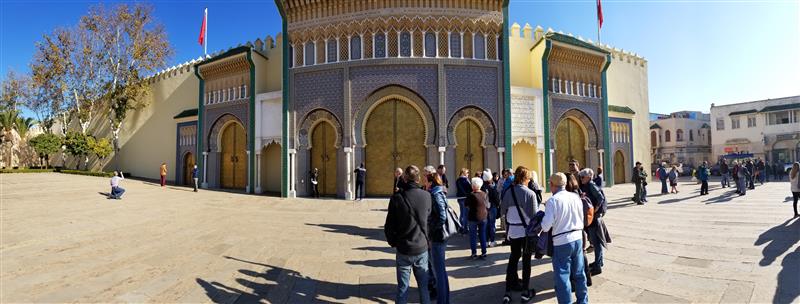
Panorama of royal palace in Fez
Most of the rest of the day was spent in the medina, the old part a Moroccan city behind the city walls. This one is a UNESCO world heritage site and is preserved as it has been for hundreds of years. The narrow streets are literally a maze of very small shops selling virtually everything. No vehicles are allowed, but you must make way for donkeys and mules and hand carts.
Detail with hanging plants - narrow alley in Fez medina
Restored Jewish Synagogue in Fez
Most of the Jews who had lived in Morocco for centuries, left to go to Israel, Europe, Canada and the US. In most cases they continue to own the property and collect rents. We visited a synagogue that had been restored in the 1990’s.
Inside restored synagogue
We climbed to the roof and could look out and see the old Jewish cemetery just behind. This synagogue is not used often for services ... when families of these "Moroccan" Jews return for visits, for example. While we were there, and Israeli tour group came through and one of the older women (a grandmother to others in the group) had lived in Morocco and her husband was buried in the cemetery. According to our guides, the Jews were not forced or encouraged to move.
Synagogue's graveyard
Selling 2 kinds of raddishes
Mount of Olives in Fez Medina
Flattening and cooking crepes. Rounded, black shape is the cooker.
Fresh strawberries
Dying Morocco "silk" - the fiber from Agave plants
Closeup of dying "silk"
Coppersmith in Fez Medina
Elaine looking at the metal wares
Interior of old (unused) Muslim school (madras)
Elaine and Tom inside madras
Shop selling wedding caftans
in Fez Medina
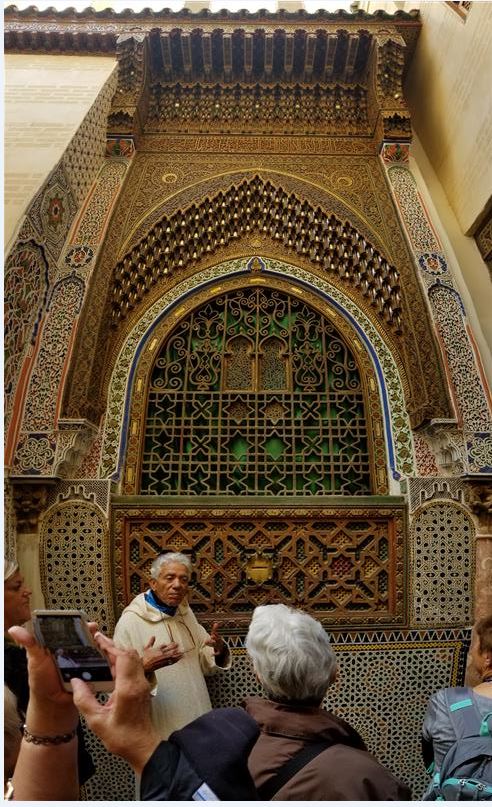
Tomb of founder of Fez
Elaine places her hand on the door of tomb and makes a wish.
Shop in Fez Medina selling used silver items
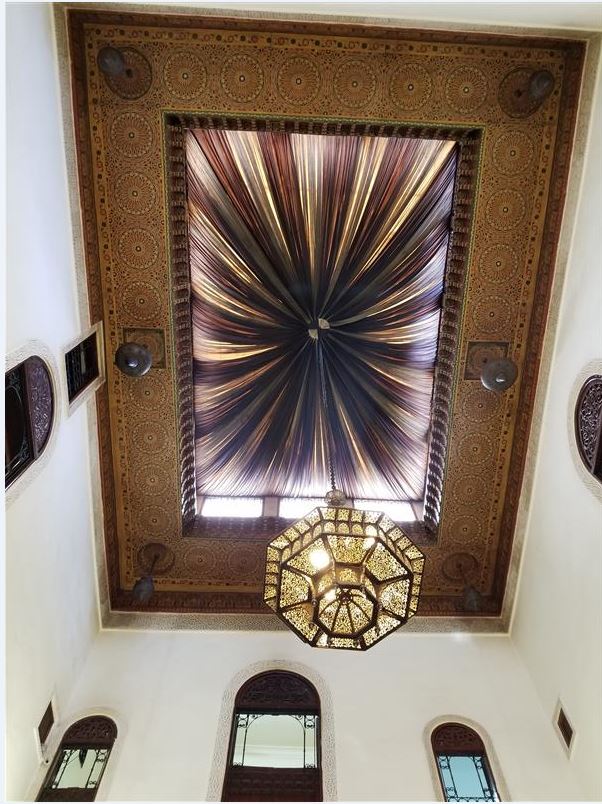
Ceiling detail of our lunch restaurant in Fez Medina
Tom taking photo of our lunch tagine
Chicken with vegetables - tagine
and Tom's couscous with vegetables
Joel, Elaine, Sue, Laurie, Pete and Tom having lunch in Fez restaurant.
Tom and Joel at leather factory
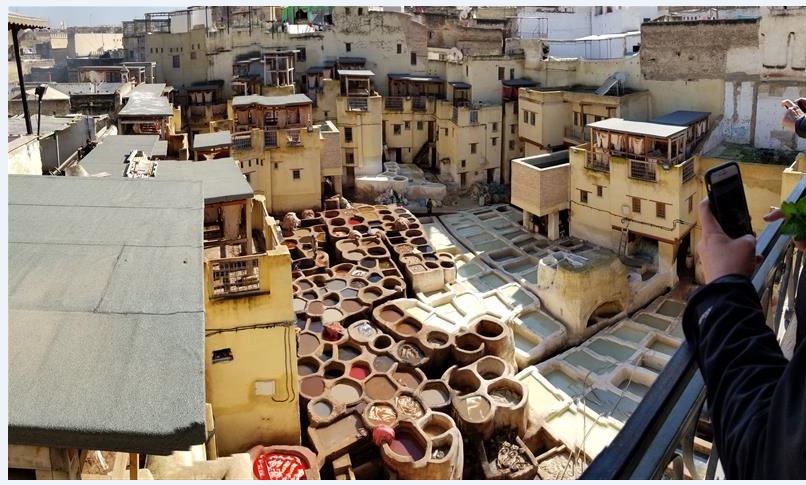
View of leather operation from rooftop. Curing and drying and dying vats
We climbed to the roof to look over the leather tanning and dying operation. We were given sprigs of mint to hold over our noses. Back in the shop, we saw all kinds of leather goods. We were told that goat skins treated with their natural processes, made the best leather coats, etc. They demonstrated that they were waterproof, very soft and came in many different colors. If we wanted a coat made to our measurements, they would have it ready in a few hours.
Hides drying
Elaine and Tom wearing scarves done up as turbans
Next stop was the weavers. It is house in an old Foundouk which was formerly used to house travelers in caravans and their animals. A principal fiber in this weaving is Moroccan silk which comes from the agave plant. They also weave wool and cotton. The scarf can be drawn over the nose to protect from blowing sand in the desert. They also had wide and long fabrics in bright colors for tablecloths
Virginia wearing head scarf
After a busy day, we had some time for “ten toes up” (as our African Safari guide often said) before getting ready for a home hosted dinner. We were divided into 3 groups of 5 each going to a different residences for a dinner. The Daniels’s, joined by Tina & Vicki, went to an apartment in the “Ville Nouvelle” new city. The host spoke very good English and we had a delightful evening getting to know them, and visa-versa. The wife had cooked a delicious tagine of lamb which had simmered with onions, garlic and spices for 3 to 4 hours on top of the stove. We were also served soup, salads, and olives from the family farm. Our host no longer manages the farm, but works for a real estate developer. The evening ended with some video highlights of the couples wedding 21 years ago. A wedding planner was hired and a huge celebration lasted all night and into the morning.
Wow. Your stays in the older parts of the cities are fascinating. I do want one of those mosaic tables for my balcony. Since you didn't have to tote the wheelchair, do you think you might bring me one?
Hugs,
Ruth
Those mosaics and pottery were BEAUTIFUL! [Actually all of it was pretty beautiful!]--- Nancy D
Photos of Fez are wonderful. Thanks for sending. -- Rosemary J
Wonderful photos and descriptions. Thank you so much for doing this. What a great trip! Everything you share is beautiful and educational! Food looks delicious! Yum -- Carol S
thanks tom, really enjoying your account. why isn’t terry with you? -- molly
Yep. You hit the highlights- colors, smells, tastes, textures. A wonderful city with old city walls propped up and reinforced with timbers and rods. Love the tagines. -- Jon S
This morning our little group, Tom, Joel & Elaine, decided to forgo the optional tour and take it easy in Fes. We wanted to leave the medina and to the Nouvelle Ville, the New City. We hade passed by a modern shopping center several times and we thought it would be nice to do a comparison. We were advised to get into a “petit” taxi which holds up to 3 passengers and in this city is red. We thought we could walk it, but it was a pretty uninteresting stretch. It cost about a dollar.
Borj Fez: modern shopping center
Ladies kaftans
Tom and Joel at the Nespresso Store
The salesman here is reading books to learn English, and seemed to be happy to visit with us. He knew it was fruitless to try to sell us anything.
Car for Terry
Department store in the lower level of the mall
Stoves
for sale (price is about $180 for stove top)
Joel looking at pastas
Lentils (about $1/pound)
Spices
Joel and Top sitting down for Cafe Americaine at an Italian coffee shop
Valentine's Day (today!!) coffee cups
Elaine in front of Carly's Shoe Store
Joel buying a pair of Birkenstocks
Joel and Tom on our way back to our riad
Red Petit Taxi's
-
Tom trying to fit into the Petit Taxi
Batha Museum near our riad
Andalusian Gardens inside the museum
Half/Half pizza for late lunch (vegetariene and cheese)
A nice sunny day and we feel much more rested. We’re getting good exercise climbing up stains. At our home-hosted dinner last night, we had to walk up 4 (seemed like 40) flights of steps. At the riad J and E have to walk up a couple of flights of narrow spiral stairs.
We were up early to get to the bus for a long ride south of Fez to the desert. To get there, we had to cross the Middle Atlas Mountains climbing to an elevation of over 7,000 ft.
Donkey and cart outside our hotel in Fez
Snow as we started up the Atlas Mountains
Most of the day’s driving was on secondary roads quite narrow in some places. The bus is comfortable and we stop occasionally to stretch our legs, use the facilities, and get some coffee. Mostly, Moroccans think of coffee as a shot of expresso filling about 1/3 of a small cup. We ask for a café long or Americano, but most of the time that doesn’t do much good. Yesterday Tom & Joel asked for coffee to go and they brought out the tiniest paper cups we’ve ever seen with a snap on lid. Hardly worth the effort since there were only about 2 swallows. Sometimes we ask for “nus nus” which is coffee and hot milk. It might come layered with foam on top. At least there is more to drink. Perhaps that is an Arabic term. The closest to American coffee is at breakfast in the hotels although it is undoubtedly powdered and prepared for a carafe.
Ifrane: a "Swiss" village voted prettiest small town in Morocco
It was only a short way from Fez where we began to climb and got into snow. The roads were clear, and it was beautiful stretching out to the high mountains. We stopped in Ifane, the Switzerland of Morocco, and that’s exactly what it was. Vacation houses, hotels and a university.
Al Akhawayn University in Ifrane is an independent, public, not-for-profit, coeducational Moroccan university committed to educating future citizen-leaders of Morocco and the world through a globally oriented, English-language, liberal-arts curriculum based on the American system.
There is some skiing for a short period and the rest of the year it is a cooler place to come, enjoy the hiking, and take in the scenery.
Tom, Joel and Elaine in Ifrane
Tom and Elaine ready to get some coffee in Ifrane
Ifrane town square
Elaine in Ifrane city park
Taking a pix of Tom taking a photo.
Mohammed our bus driver and Abdu our bus boy
Our patient and skillful bus driver with his assistant. Everyone seemed relaxed as we negotiated a very narrow highway skirting the cliff above the river and a large dam. I think some of us were glad to have taken some Dramamine. The speed limit is very strict and police set up numerous roadblocks, particularly as we get closer to Algeria with whom the Moroccans have some “issues” we are told. That lecture is forthcoming so we will probably know more later on.
Direction signs in Ifrane
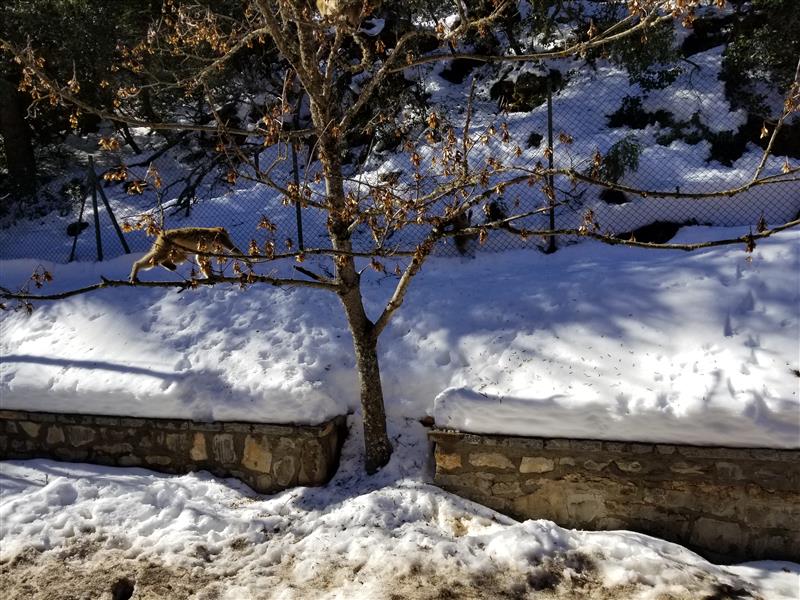
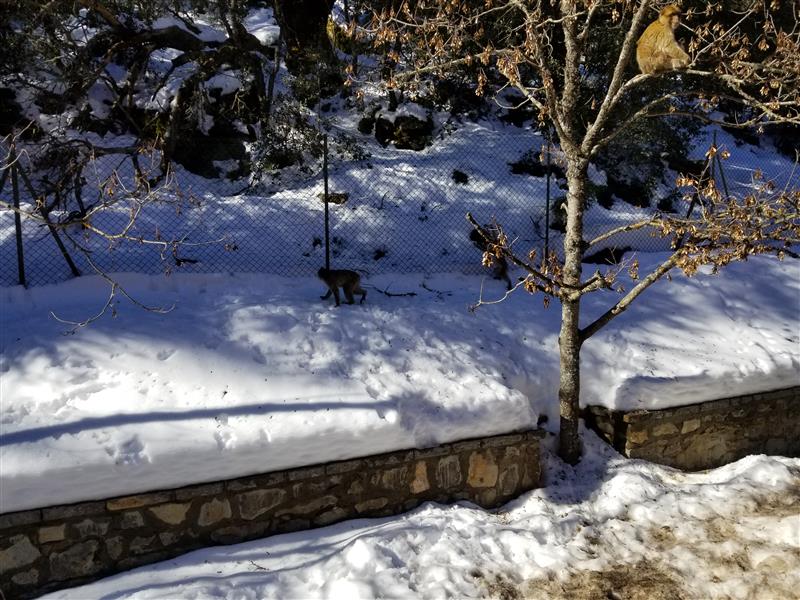
Gilbraltar monkeys (Barbary Macaques) in tree and in the snow
Tom on bus to Erfoud
We are not on BS Tours!
We were a little concerned as we traveled along behind the BS Tours, but felt better when we saw it stood for Best Services. Whew! For a while we followed a small van that had a platform on top. He had some hay, sheep, and lambs and was headed for some market. Fortunately, he had netting over the load so we didn’t see any adventuresome sheep leaping to freedom. Every town has its market day and there are itinerants who travel to the different towns depending on the day.
Joel, Pete and Tom ready to eat at our lunch stop
Tom's vegetarian tagine. The others ate trout
Joel at lunch restaurant
Elaine
outside lunch restaurant
Lower elevation on east side of mountains ... palm trees again.
One of the many dams
"Oasis" and village in river valley
Elaine ready to return to bus
Swimming pool at Hotel Chergui Kasbah at Erfoud
Hotel room at Chergui Kasbah
just ouside of Erfoud
Sink at Chergui Kasbah
CNN anyone?
Elaine at outside hallway at Chergui Kasbah
Hotel gounds at Chergui Kasbah
Good News! You won’t hear from us for a couple days since we leave this place by off-road vehicles to go camping and riding camels in the desert. No WiFi nor cell service!!
We must leave our suitcases with the big bus and hop on Toyota Land Cruisers. So we’re deciding what we need to take in small bags. Stay tuned…..
Didn't go to the Nouvelle Ville- so did not have that experience. Contrast to la Vieille Ville where I didn't find pizza! Great weather! --- Jon S
Thanks, Tom, Joel, and Elaine. These are some of the best photographs yet. -- don and danny
So, can you bring home one of those red cars………it’s really cute and would be fun to drive around Keizer. :o) -- Linda
Hello Daniels Travelers-- Looks like you had an interesting visit to the Fez mall. I am sure all the spices were intoxicating to smell. The thermometer advertising for the "LuCaffee" coffee would be considered racist, if it were in the US. Maybe not in Morocco. Keep those travelogues coming! -- Kim
Tom: Thanks for the picture and tour of the shopping center. I always enjoy your commentary and pictures. Going to the Class luncheon today. Wish you were here or I was there. Enjoy, ---Sharon
See you on March 1st at Fromm. I will tell our group the good news! Ricardo and I love your blog. We met on board a cruise to Morocco. Casablanca was the first stop but we never had a chance to see or enjoy the other cities you are visiting.
Thanks again! -- Rosemary
Friday morning, we were asked to have our suitcases out early so they could be stored on the bus while we were transferring to the desert with small bags and a ride on Toyota Land Cruisers.
Tom and Joel leaving Chergui Kasbah Hotel in Erfoud
"Fossil" sink in Erfoud hotel
Tom, Joel, Pete, Sue and Youssef getting into Toyota Land Cruiser 4X4's
Soon we arrived at a factory that makes beautiful objects out of the fossil embedded rock found in these parts. Some of it is sliced in sheets, polished and make into tables and counter tops. Popular are vanity sinks like we have found in our tents.
Tom at Fossil factory
Tom pointing out fossils in slabs
We were quite taken and sorely tempted with all they had to offer. Later in the day we went to an area where we could look for fossils. It was impossible not to find them.
More fossils
Elaine with squid fossils
After a couple hours, we left the road and traversed a graveled plain as flat as if it had been graded. We arrived at the drop off for the camel rides. Those brave enough, mounted their ships of the desert and started across the dunes toward our camp. The cruisers let some air out of their tires and took the rest of us directly to our tents. It was fun to swoop over the dunes wondering what might be on the other side.
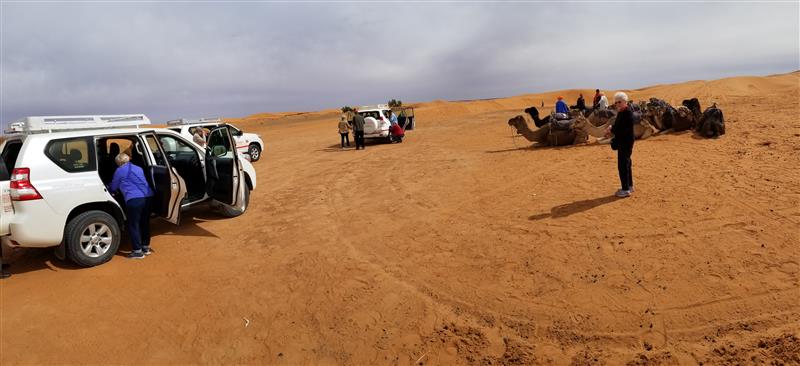
Getting ready to ride camels
to our desert camp
Elaine feeding bread to camels
Happy Camel
Pete, Laurie and Melinda on their camels
Camel driver with Steve
We arrived at our small village, found our tents, and were ready for lunch. All the food is prepared here and is all in the Moroccan style. It turned out we weren’t quite as remote as we might have first thought, as more camel trains came by. OAT uses this site exclusively though it is run by one of the hotels. In our tents we have carpets on the sand, a bed, toilets and showers. Although it is warm in the daytime, it cools down dramatically as the sun sets, so layered clothing is the order of the day. With no heat in the tents, and temperatures at or below freezing, the heavy blankets are a must.
Arrival at our desert camp
Tom and Joel on the desert swing
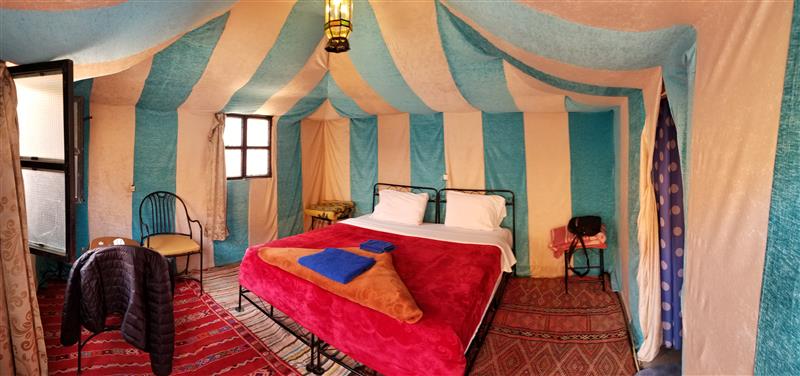
Bedroom in desert tent (bathroom door to the right)
Joel and Virginia at the dining table
Our camel train arrives at our camp
Dismounting from camels
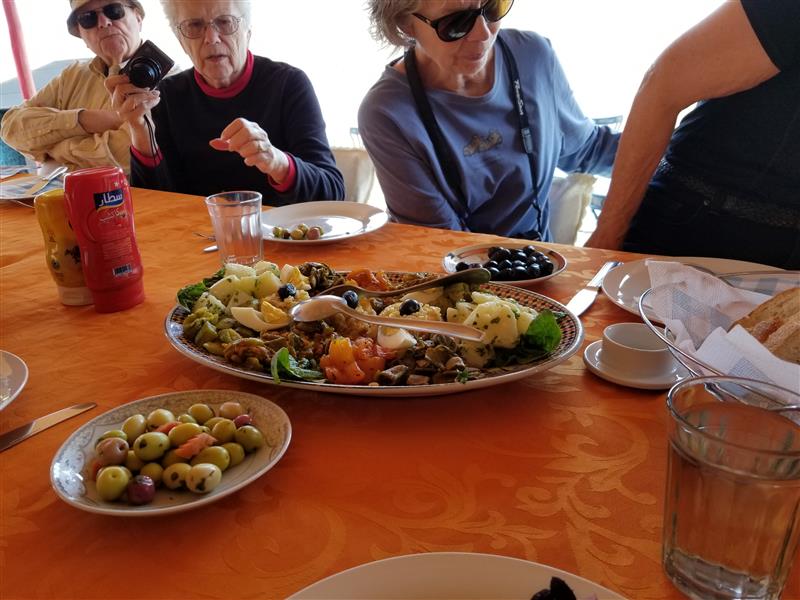
Joel, Elaine, Laurie getting ready for lunch (Moroccan salad)
Ground beef (mixed with spices: very typical) and fries.
Fossil hunting
Before dinner, we had a demonstration by the cook on how to prepare a chicken-vegetable tajine. They turned out to taste just as good as we had imagined when we ate them. Most of our meals start with a big platter of 6 or 8 salads followed by a main course. And even breakfast has black and green olives.
Desert flower
Boys selling souvenirs
This morning we stepped out of the tent after a hot shower and realized that the temp might get up to 70 so we stripped off the long johns before departing on the days adventures. It was back into the cruisers to go make some visits.
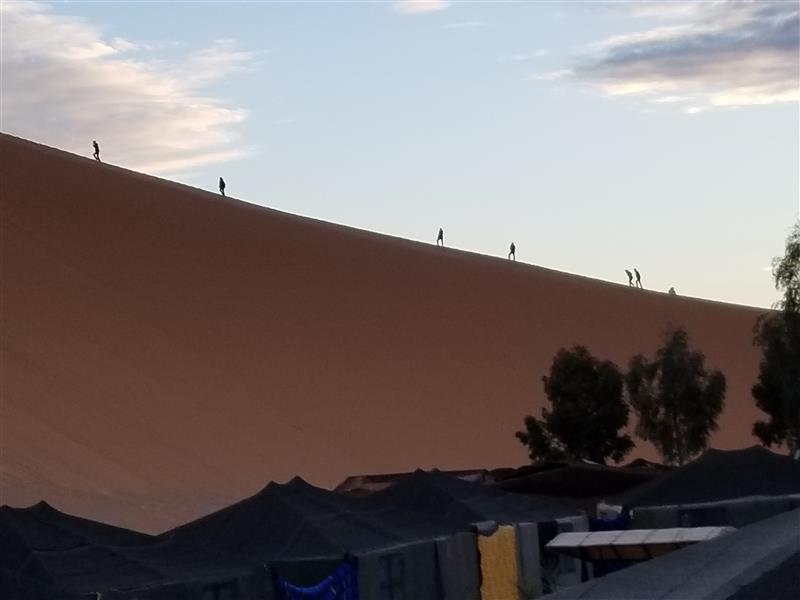
Sunrise climb on sand dunes
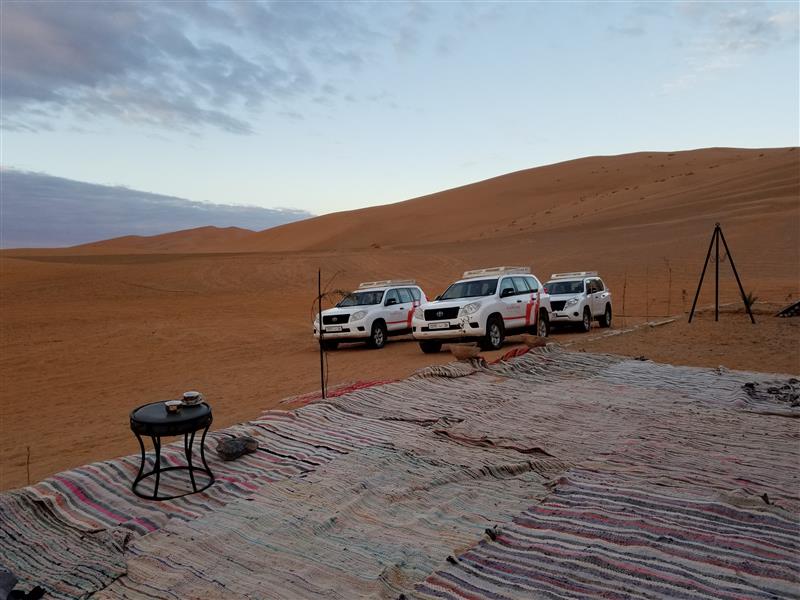
Our Toyota Land Cruiser getting ready for the day's excursion
Tom and Elaine at the camp's sand dunes
Tents at our campsite
Visit to date palm farm
First on tap was a visit to Mohammad’s farm, a small homesteaded plot of ground just right for subsistence farming. He was very welcoming and took us out to see his fields while our drivers went to have their tires re-inflated.
Youssef listening to the date farmer
Farmer and granddaughter telling us about date farming
Mohammad has a farm that is primarily dates. He explained all about cultivation of this crop. He has about 150 trees, one of them male. He takes a small sprig from the male tree and ties it into the female blossom to aid in pollination. The prized dates are the Medjouls. The trees put out sprouts and can be planted or sold to make new trees.
Medjul date palm
This desert has rivers flowing beneath the sand and one needs only to dig down a short distance to get water. One of his wells is salty, and another fresh. He mixes them to irrigate. He has a gas pump for one, and electric for the other.
Gasoline engine powered pump
Water down in the well
Pumping water into a cistern
Bringing drinkable water to the farm home
Coriander plants
Between the palms, he has various crops planted in small plots that are flood irrigated. Crops are barley, alfalfa, fava beans, garlic, onions, dill, coriander, parsley, carrots, etc.
Gravity flowing water into channels
We walked back up to his house and his wife and daughters had tea prepared for us, as well as dates & peanuts. Near the house he has pens for sheep, goats and chickens. We’re not sure, but some of the animals may be driven out to forage.
Black and white sheep
Farmer serving dates and peanuts and tea
His house is small and made out of sun-dried bricks covered with mud and straw. There was a satellite dish outside. Our guide had some gifts and money for him and his family. He supplements his living from travelers such as us.
Satellite dish at farmer's home
We drove on to a small village where we visited a gnaoua, descendants of the people of the various waves of migrants from sub-Saharan Africa who carry on an ancient music tradition. We were served tea and listened to about a 30 minute concert with singing and traditional instruments. It was hypnotic and they are very good at what they do, a national treasure.
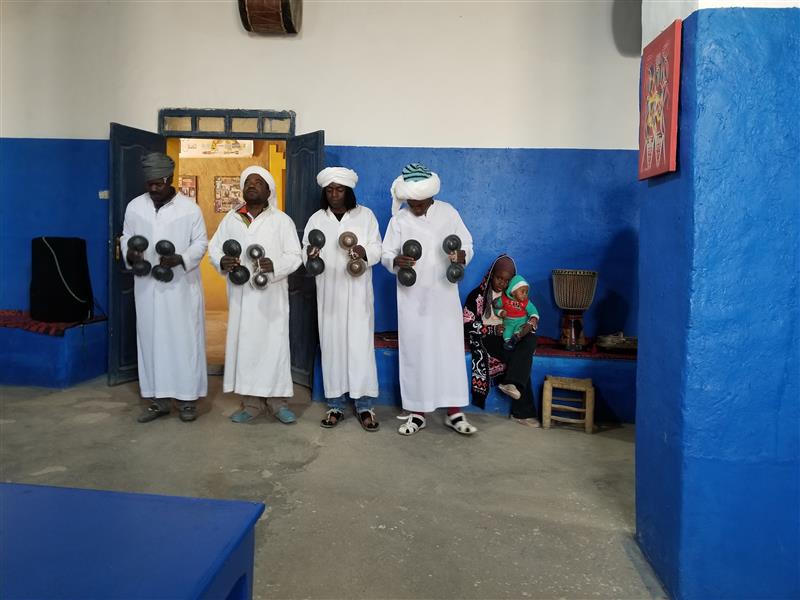
Entertained by music cooperative/school
Stopped at nomad's home. Note "hobbled" camel
On our way back to the desert camp, we stopped to visit with a nomad family living in a very basic way on the sand. The family consisted of a mother of 5 whose husband has died. One of her sons, his wife and child continue to live with her. They have a few camels and several are saddled in case someone comes by and wants to ride.
They had several small rooms made from mud bricks with holes for windows, and in front a tent of woven camel & goat hair that would repel the rain. She put a rug on the floor and served us sweet mint tea.
Nomads entertaining us under the tent canopy
Youssef pouring tea
Our guide had brought come cookies to have. She was quite engaging through our interpreter and soon lowered her scarf so we could see her face. Our guide had also brought her a box of tea and lump sugar. He might have given her some cash as she had so little. She said she goes to stay with her daughter occasionally. None of her children were able to go to school, but it is possible that the grandchild, who is about 2, can go live with an aunt so she can go to school. We didn’t see much sign of any transportation, and they were very remote.
Under tent canopy. Woven from camel and sheep's wool
Virginia and Kelly with nomad grandmother and grandson
Drivers letting air out of tires so we can drive on the sand dunes
Lunch: Cauliflower, beets, rice/corn, eggplant, squash and lentils!
Chicken on skewers, rice/peas and fresh green beans.
We headed back to the camp and had a little time before our guide gave us his perspectives on Islam. It got dark before dinner and the sky was spectacular. Several of our people had apps for their phones and iPads that show the heavens and identify the stars as you hold them up to the sky.
Before we ate, the cook came out and demonstrated how she made a Berber pizza. She had some dough that might have been whole wheat which she divided in half. She had a shallow bowl with some oil and semolina flour in it. She flattened one part, then put on a mixture of cooked hamburger, onions, chopped cooked eggs and spices including garlic, turmeric (always turmeric) and put the other half on top. She crimped the edges and flattened it out. It was whisked away to an oven.
It was back to a cooold bed. Tom overheard the guide talking about using a 1.5 ltr water bottle, filling it with hot water, and putting it in his bed. We were so jealous that we hadn’t thought of it. Despite the chill, the location for the camp, camouflaged like a Berber tent, is located in a perfect setting with the dunes
Hey Tom,how are you? I really enjoy your pictures from Morocco!!! Guess what? I'll be there in late March!:) Doing almost the same tour you guys seem to be doing... Craziness!!!!!
Craziness!!!!!  So it' s even more inspiring to see your pics!;) Hope you're doing well!please say Hi to Joel and Elaine,also from my parents! Enjoy the rest of your Trip!!!:)
Sarah G
So it' s even more inspiring to see your pics!;) Hope you're doing well!please say Hi to Joel and Elaine,also from my parents! Enjoy the rest of your Trip!!!:)
Sarah G
This is a marvelous trip, Tom. Good food and lovely hotel accommodations. Also magnificent scenery. Hope you also scored good travel companions. Have a good internet break! -- Sylvia S
Brave you camping and riding camels....Have fun! -- Cheryl
Hi Tom, I have really enjoyed reading your fine travel log and your photo’s are a wonderful way of following your trip. Thank you for including me. -- Dick P
Have fun! No camel races, you three! -- Ruth
What a grand adventure in Morocco! Sorry you can't find a good cup of coffee there. (Wasn't coffee an Arabic discovery?) Safe journeys into the desert. -- Kim
Wonderful photos....!!!!! I was not expecting snow in Morocco! The elevation must be the factor here. -- Janek
I look forward to hear about your next adventure. You do such exciting things and visit amazing places. This is so interesting to see how so many people live away from “civilization. -- Carol S
Did your road over the mountains go to Ouarzazate? I remember the hairpin curves winding over the Atlas Mts. My Moroccan friend invited his cousin to come along that day. She was not used to riding in a car and was sick and vomiting most of the way. I wonder if she ever asked to go on excursions after that day. The adventure continues. Fun. Jon S
It was up, up and get ready to disembark the sea of sand for the mountain city of Ouarzazate (War za zaat).
Elaine waking up in a cold tent.
We were heading to breakfast before daybreak and marveled once again at the magnificent dunes that are constantly moving, shaping and rebuilding. We must realize at the same time that the Sahara is growing and moving dunes are a threat to the people living here trying to scratch out a living. We have been in the SE of Morocco in a small area of desert; there are huge ones further south and west.
Camel caravan came by our camp
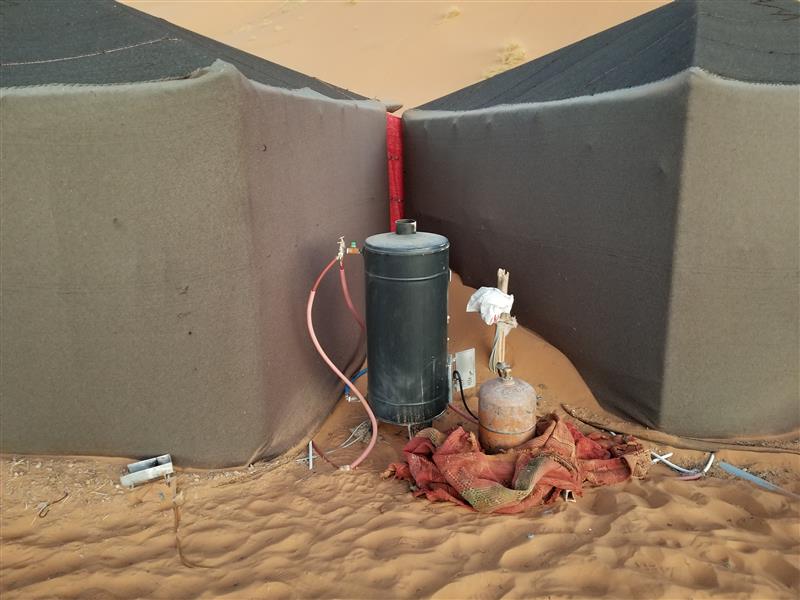
Water heater for my tent
Each tent had a small on-demand water heater that works efficiently. Water has to be brought in and there are some solar units which with batteries provide elecricity for lights, refrigerators, chargers, etc.
Tom and Elaine getting ready to depart from the camp
Putting air back into the 4 tires
Youssef showing us dates at the market on our way to Ouarzazate
We stopped at a good place to buy some dates. After we had tasted some, customers weren’t hard to come by.
Mounds of dug out material to make undergroud aquaduct. Different tribes built their own parallel underground aquaducts (see mounds to the left in the above photo.)
We made a brief stop to visit one of the massive ancient underground wells and tunnels used to get water from an aquifer. Wells are drilled then water is tapped and diverted to large underground aqueducts. These were used all over the desert countries. Now they no longer work due to global climate change. They have largely been replaced by the huge system of dams Morocco has built in recent years.
Creating the underground aquaduct
About 25 feet below the surface is the dry (unused) aquaduct tunnel. Too much water would have evaporated if open canals were used.
Shopping!
Tom trying on another scarf
Just before lunch, we went to a wonderful Berber Museum in Ksar of El Khorbat. Ksar is a fortified old walled city. We saw all kinds of artifacts from days gone by, although surely there are places that still use them. Some of the items were not strange to us and could have been found in our grandparent’s farms.
Joel at the Berber Museum
The organization that runs the museum, prepared a lunch for us which was one of the best we’ve had. We had turkey, among other items that was fixed in an entirely different way. (see below)
Lunch at the Berber Museum: croquettes, rice and fries
Turkey scaloppini
We had two nights at Le Berbere Palace, one of the largest hotels, (and our guide assures us) one of the nicest in Ouarzazate. A good, long & hot shower washed off the desert dust before we put on clean clothes.
Elaine and Joel in front of our hotel in Ouarzazate
Joel with Tom's who is taking his dirty clothes to be laundered
Our supper was a buffet in the dining room of this hotel. There were dozens of students and others from China and Japan. The menu was mostly French, and pork was served at breakfast, an item not found in most of the country.
Ouarzazate area is where many movies have been filmed and this hotel has many aftifacts from these movies.
Aït Benhaddou
The "old" town on the right has been abandoned for the "new" city on the left (In the picture above). The river (green) was impossible to cross to the main highway in winter.
We stopped here for a view before we went into the town to begin our “Day in the Life,” a program of OAT and the Grand Circle Foundation to allow visitors to spend some time being introduced to the lives of ordinary citizens in the countries they visit. Another part of its mission is to make direct donations to these villages in money and projects such as a new school. As of this year, the foundation has made grants and pledges of $97 million.
Pete with desert snake around his neck!
Front door of house we visited in
Aït Benhaddou, a Unesco world heritage site.
We were invited into a typical house of the village. We sat and visited with her for a while and then toured most of the rest of the home. Her house is larger than many of the others because her husband was a mason and could keep adding on. Several relatives live in attached homes. At her request we are including no pictures of her (to go on the Internet).
Baby goat in the barn portion of the house we visited
Kitchen of the house
Tina, Joel and Elaine near the pantry in kitchen
The son who lives in that house is an artist.
He put the paintings over a flame to bring out the bright colors. This technique came from "secret" writing where the words would appear with heat. The pigments are natural ingredients: indigo, saffron, etc.
Village lady cutting greens (alfalfa) for cows and mother goats.
We visited
a kindergarten class in the village
Our next stop was a kindergarten class in the town school. The two women are teachers and have morning and afternoon classes with different students after the noon break.
We brought some gifts for the class. They sang a patriotic song for us complete with a very rousing climax. They are taught in Arabic and French, though Berber is beginning to be taught since that’s the language most speak.
Youssef is pointing out North America on blow up globe that Joel and Elaine brought for the class. Unfortunately Morocco is shown on the map as a divided country which is no longer the case.
Alphabet chart (French) on classroom wall
Visit to Imik Simik Association - a womans development cooperative
A short walk took us to the Imik Simik Association, which means “little by little.” This association, created in 2012 by women in the town with no money and some resistance, to give women a hand up. A woman donated the use of a very small shop rent-free for 2 months and they decided to bake cookies to sell in the community. They have since expanded to making couscous in the old-fashioned way like women used to gather to do, and to bake bread. Grand Circle bought them a commercial convection oven and is negotiating for some land and build a building.
Ali our local guide is talking to Youssef
The women who run the association told us about it. Started in 2012 and is one of the recipients of the Grand Circle Foundation (our tour provider OAT part of GC)
We were divided up into 2 groups to help with some cooking. This group is making couscous which is made by adding some water into whole wheat flour and rubbing it between the hands. At some point when the dough is crumbly, it is passed through sieves.
Teacher is showing Elaine how couscous
is made ... adding water to semolina flour
Couscous is strained by 2 screen sizes.
The end product looks like couscous but needs to be processed. First it is placed in a type of double boiler and steamed. Then it is spread out to dry. In the winter, that takes about 6 days. Then it’s eaten or packaged and sold. The holy day for Muslims is Friday and it is the custom to have couscous on that day.
Steaming the couscous
Melinda, Elaine and Tom and cookie dough
The other group worked on rolling out a sugar cookie and cutting them into shapes to be baked. Some were filled. In the shop was a case with lots of different cookies for sale. We can attest that they are very good.
Cookies are filled with jam
Tom and Joel carrying our lunch to a nearby house
We went to a nearby house of one of the women where we had lunch. It was a couple blocks away and we were asked to help carry items we would have: couscous, chicken cooked in a delicious sauce, various cooked veggies followed by tea, cookies and tangerines.
Melinda and Steve are dressed is typical Berber costumes
Randi getting henna painted on her palm.
Virginia showing off her henna tattoo
Great photos...loved all the fossils....That is the only way to go camping....nice -- Cheryl
Elaine!! I love your jammies. -- Pam and Larry
Hi Tom and Daniels Caravan, I was drooling over the display of dates in your photographs. And the display about underground canals was interesting, too.
Tom, are you going to return state-side with a totally new collection of scarves? -- Kim
I'll never complain about my tiny kitchen and counter area again! --- Almeta
Real couscous is complicated and takes time. Glad you got to experience the process. The kindergarten looks 5 star compared to the schools where I go in Kenya.
Morocco is more modern thanks to the king who generally has a positive attitude toward development. Maybe less corruption that elsewhere. En reality, he does not want uprisings in his country like others in North Africa. -- Jon S
Your tents are amazing – not what one considers typical tents! -- Nancy D
Joel, these pictures are wonderful. Thank you for sharing them. It a little after 12:30 pm here. I am about to take off for the coast. Glad I checked my email first !!
Continue have a fabulous time!! See you !!
-- Donna Y
Hello Tom, Each of your mails have been most fascinating and really informative.
I have had friends that have gone to Morocco , but none have had the
experiences you are enjoying. I want to hear how such a trip is organized. Your photo’s and commentary are most informed and do give a sense of what you are doing. Thanks a lot for keeping me
in the loop. -- Dick P
Yes, I also stayed at the Berbere Palace and took some of the same pictures.
Would love to have stayed in Berber tents and visit with them – alas that was not on the Globus itinerary (perhaps because we were a large group?) Enjoy the rest of your visit! --
Jon H
It was an early wakeup call since we wanted to be on our way south to the city of Marrakech, the city of about 1.5 million called the Las Vegas of Morocco. (We can’t say yet if we think that is true.) The road takes you over the Atlas Mountains where the pass is about 7,200 ft. The eastern flank is the poorest national road we have seen yet, but they are working on it. So very narrow, we were inclined to look the other way when passing a truck on a curve. It is only 150 miles or so, but we went so slowly, it took all morning.
Atlas Film Studio just outside of Ouarzazate
Atlas Film Studio and Oscar Hotel
The Ouarzazate area is a noted film-making location, with Morocco's biggest studios inviting many international companies to work here. Films such as:
Lawrence of Arabia (1962)
The Living Daylights (1987),
The Last Temptation of Christ (1988)
The Mummy (1999),
Gladiator (2000),
Kingdom of Heaven (2005)
Kundun (1997),
Legionnaire (1998),
Hanna (2011),
The Hills Have Eyes (2006), and
Salmon Fishing in the Yemen (2011)
Asterix & Obelix: Mission Cleopatra
The Man Who Would Be King
Babel. It was also the location of an episode of
the television series The Amazing Race 10 and
Game of Thrones (Season 3).
Prison Break Season 5
There are a number of studios in these parts: the climate’s great and there is a variety of scenery and local props. We went to a restaurant last evening called Dimitri, and the walls are covered by signed pictures of movie stars who frequented it. Think Marlon Brando, Elizabeth Taylor, Hitchcock, Paul Newman, and many more. We’re told they often stayed at our hotel.
Joel, Laurie, Cathy and Tom on sunny terrace on our way to Marrakesh
Winding mountain roads over Atlas Mountains
After the pass, we began the descent on much better road, some of it three-lane. We didn’t see any construction workers and were told the international construction company’s owner had died, and they were waiting to see who took over. Our guide wasn’t impressed by that argument.
Sheep, goats and little twin lambs at the market
We stopped at a village not far from Marrakech, where there was a huge weekly market. Everything was for sale especially fruits and vegetables. We enjoyed walking through it.
Red onions
and more red onions
Ripe tomatoes
The cardoon is a tall, thistle-like plant which resembles giant stalks of celery.
More vegetables
Youseff said this makes you "hot"
We're afraid to ask what this is used for???
Luggage off of the bus.
In our Marrakesh inn called Riad Nesma
This riad has an open courtyard and a rooftop where we had lunch. The temperature outside was just right. It has been getting warm during the day, but cools right down in late afternoon
Joel and Elaine's room at the Riad Nesma
The bed is decorated so beautifully, they plan to sleep on the couch so as not to disturb it.
Tom at his "desk" with mirror
Elaine, Joel and Tom in carriage for little tour of Marrakesh
Horses and carriages seem to be quite popular and we could see why. The animals clipped right along although not fast enough for the cars that couldn’t pass. They gave us a good horning. We went out to La Manara, an ancient reservoir that still is filled by tunnels from the mountains. It’s about 10 ft deep and has a large olive grove nearby. This property belonged to the king and was used for all sorts of things. The current king turned in into a public park. People were having picnics under the trees.
La Menara Reservoir and Garden in Marrakesh
Tom and Sue comparing GPS map to hotel map
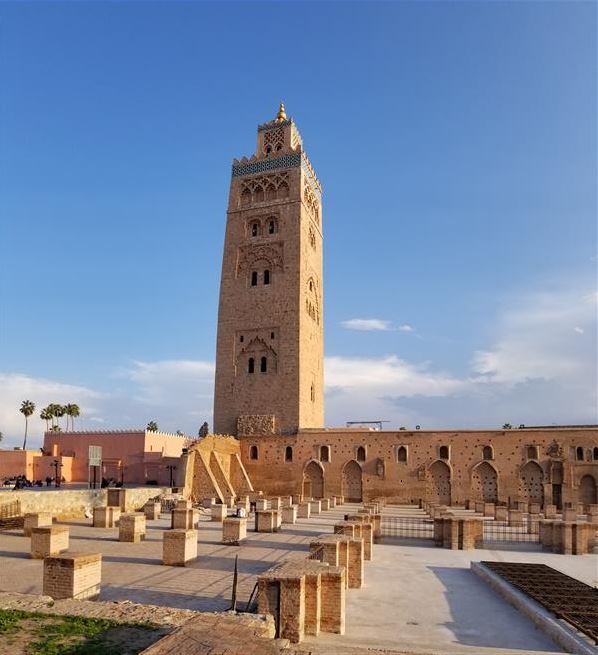
Largest mosque in Marrakesh
This mosque was built hundreds of years ago as a smaller version of the one in Rabat. The tower had beautiful blue stone that seems to change color with the light. After the mosque in the foreground was completed, it was discovered it was 5 degrees off the true direction to Mecca. Nothing would do besides tearing it down brick by brick and rebuilding. The foreground is the remains of the original. To build the tower, a ramp was used and extended bit by bit so that donkeys could carry up the bricks. The ramp was left so that the imam could ride up 5 times a day to give the call to prayer.
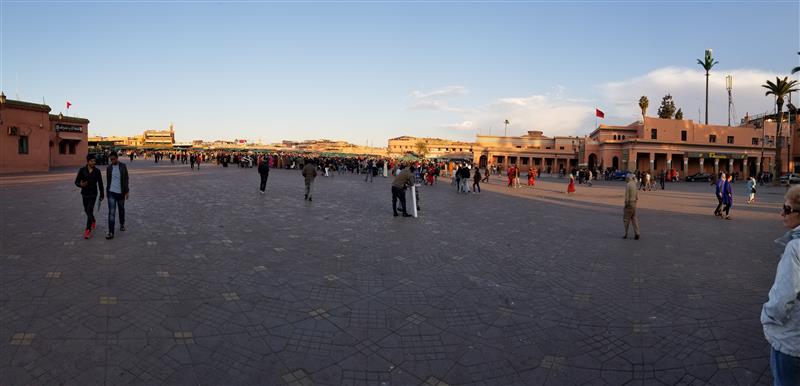
Largest square in Marrakesh
almost at sundown.
The famous place that you will hear about later. Stay tuned.
Orange juice in the Jemma el Fnaa square. Watch out for snakes! I ended up with snakes around my neck and had to pay to get them off! Gardens of one of the famous fashion designers. Have fun. Recovered from whiplash from camel ride? Oh so hard to get your leg over the saddle when dismounting! -- Jon S
Hi Daniel family! I just wanted to let you know that while going through my junk mail today, I found all your emails. I now have a lot of catching up to do. As always, I really enjoy the emails of all your ourneys.
ONWARD HO!!! Love and hugs, Jan S
Very interesting! -- Gladys
“Don't you know we're riding on the Marrakesh Express
Don't you know we're riding on the Marrakesh Express
They're taking me to Marrakesh”
And don’t tell me you’re not the right generation to know the song by Crosby, Stills and Nash!
Awww, I like your animal pictures! Love the twin lambs! What a cute baby goat! It takes both you and Joel to carry the lunch!? That must have been a lot of lunch. -- Nancy D
Joel and Elaine's bed with decorative towel shapes
Yet another design. We started at a decent hour to spend the morning walking through the medina near our hotel/inn/riad. When you venture out on the narrow winding streets of the old market, you do run the risk of being run down by a donkey cart or motorbike. When you hear a beep beep or a hee haw, you had better jump aside. The are more motorbikes in Marrakech than any city in Morocco and they are everywhere. There are so many that when the government proposed requiring helmets, there was a massive protest and the government backed down.
Huge cans of olives (bottom) and tuna, etc.
Saadian Tomb Mausoleum In Marrakesh
Tom, Joel and Elaine at Saadian Tomb Mausoleum
Saadian Tomb Mausoleum dates from around 1600 and escaped destruction by succeeding dynasties by becoming buried (no pun intended). It was discovered in 1917 and contains beautiful artwork.
More Saadian Tomb Mausoleum
Marrakesh street scene
Garden courtyard of Bahia Palace
Very near us is a historical royal palace dating to the 1800’s. After the French protectorate began it was sacked, but now has been restored. There is a large courtyard with long covered sides where there were multiple doors. The King could have his 4 wives and numerous concubines dress up and pose outside their doors to impress the guests.
Elaine (and Cathy) in courtyard of Bahia Palace
Bananas in garden at courtyard of Bahia Palace
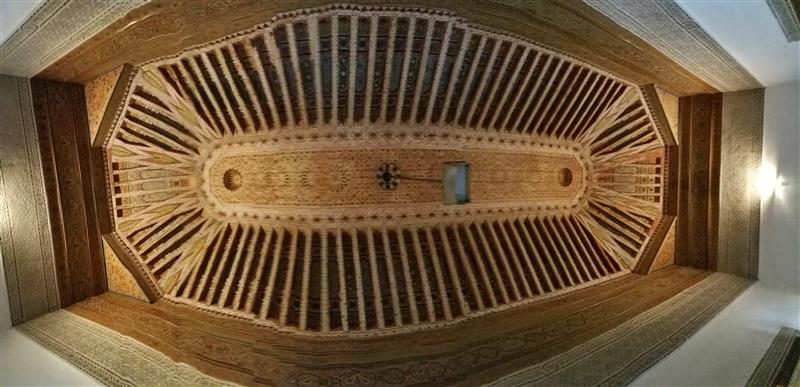
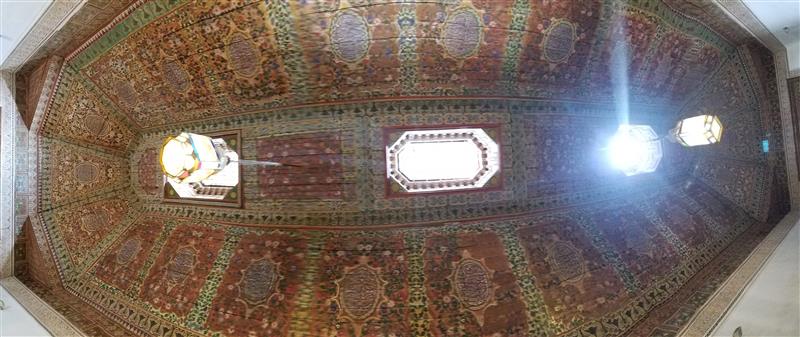
Ceiling details in 2 different rooms of Bahia Palace
Another courtyard of Bahia Palace
This above photo shows the doors of the wives and concubines. It is legal for a man to have up to 4 wives in Morocco, but it is increasingly rare for a man to have more than one. The law has changed and he would have to have written permission by his other wife/wives and go before a judge and show he can provide for them.
Stained glass in Bahia Palace
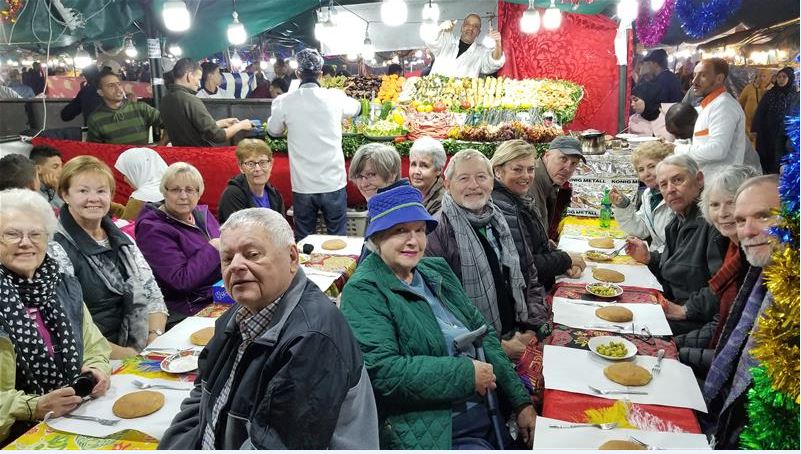
Our tour group at the food stalls in the main square in Marrakesh
For dinner, we walked to the Place Jamaa El Fna, where street vendors come out at night and set up "restaurant" stalls to serve the passersby. Youssef had reserved seats for us at booth 41. You can see all the food prepared and ready to serve behind us. It works best for a couple to sit across from on another to share, starting with bread. Olives were set out along with a red salty hot sauce. Then we received a plate of Moroccan salad which is cooked. We could order from a variety of entrees. You can see the chef on the upper right with his stove for heating everything up.
Surrounding this all sorts of other food booths and performers and things for sale. It was a little subdued on this cold winter night, but later on in the year, things get very lively. As we were eating, Youssef went out and got one of his favorites: An egg & potato sandwich.
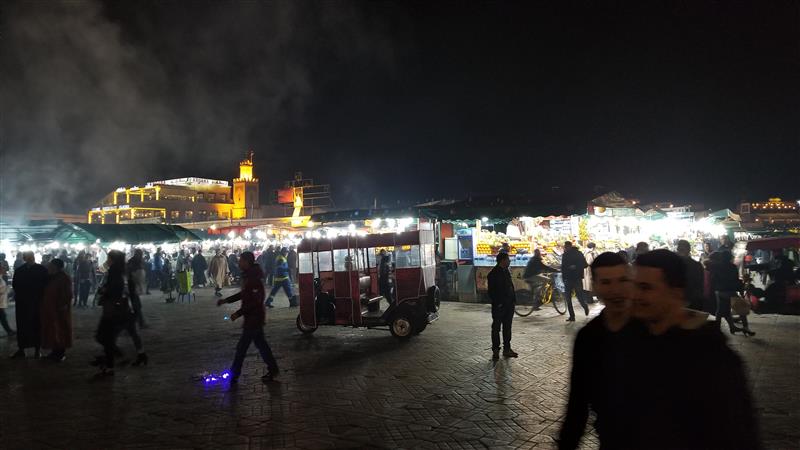
Night scene at Marrakesh main square
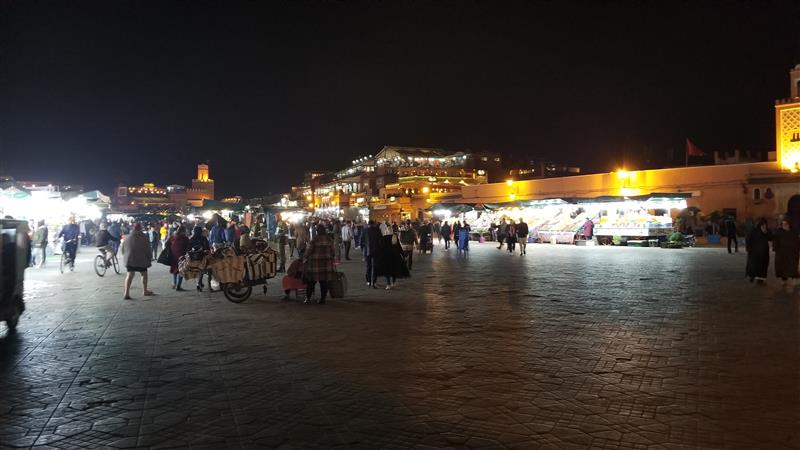
Another night scene
Thanks for the travel guide, love it. -- Sharon S
Elaine, Joel and Tom decided after breakfast to walk to the garden and museums although it was a little over tw2 miles away. The weather was perfect and who knows what we would run in to.
Breakfast at Riad Nesam
Joel waiting for eggs to finish cooking in tagine
Almost well done
Randi and Elaine getting ready for the morning's trek
Near the Riad Nesma where we’re staying, there seems to be lots of road repair going on. The street is narrow, and that is where all the sewer, electric, and water lines are. When repairs are needed, the workers work mainly at night and then close it up for traffic the next day.
The "street" of our riad
Joel looking at Couscous Sifters (round with screen bottoms)
The man below is wearing the traditional shoes that come in all colors, yellow preferred. The back of the shoe is turned down but can be pulled up if it rains. Sellers are very busy trying to get you to buy their wares. They may get you mint tea if they think there’s a chance you’ll buy.
Vendor trying to sell Joel and Tom some fabrics
Repairing the medina street of our Riad
Some work continuing during the day. The cobble stones are laid and sand brushed in between.
Joel and Tom thinking about renting a bike!
Elaine and Tom on street to the Majorelle Gardens
School bus with crayola decorations
Just inside the Majorelle Gardens
After walking for about an hour fifteen, we arrived at are destination, the Majorelle Gardens. In the 1920’s, French artist, Jacques Majorelle (1886-1962) purchased some property on the outskirts of Marrakech and built a garden and eventually a home. After his death the gardens remained open but it fell into disrepair. In the 1980’s the garden and villa were rediscovered in the 1980s, by fashion designers, Yves Saint-Laurent and Pierre Bergé who set about restoring it and saving it. Majorelle's former studio workshop has become the location of the Islamic Art Museum of Marrakech which features a collection of North African textiles from Saint-Laurent's personal collection as well as ceramics and jewelry.
Elaine looking at the big cactus gardens
Tom on garden walkway
Two bites to eat with coffee at the garden
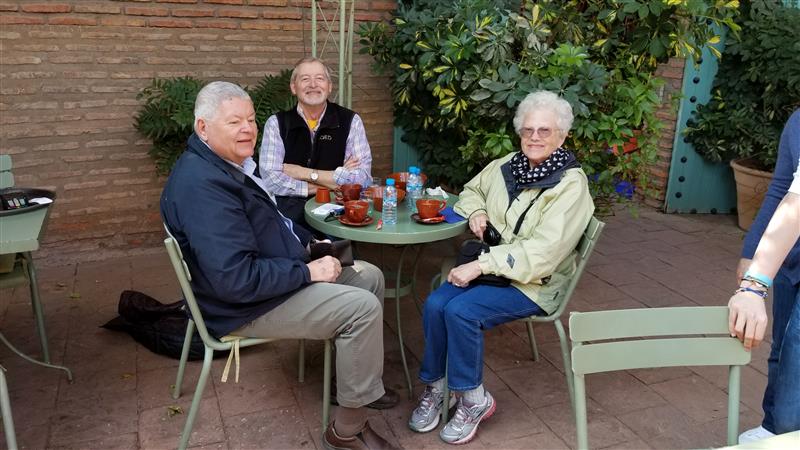
Joel, Tom and Elaine sitting outdoors at Majorelle Garden Cafe
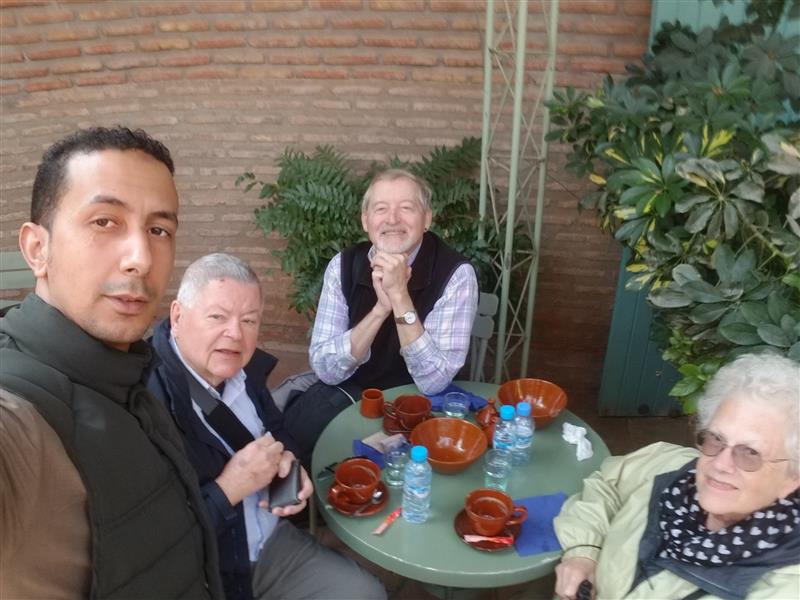
Waiter accidentally got into this photo!!!
Elaine and Tom at the Berber Museum inside the Majorelle Gardens
Goldfish in the palms
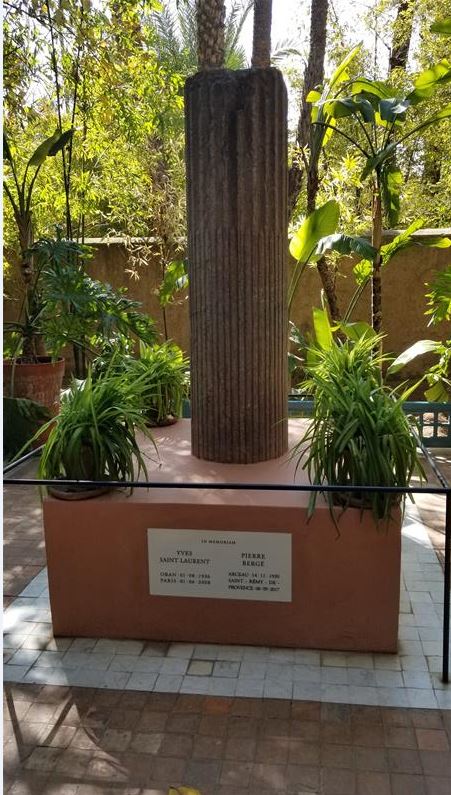
Yves Saint Laurent Memorial
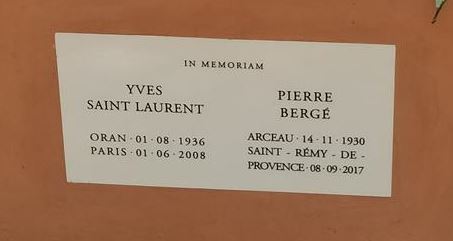
Yves Saint Laurnet and his partner Pierre Berge
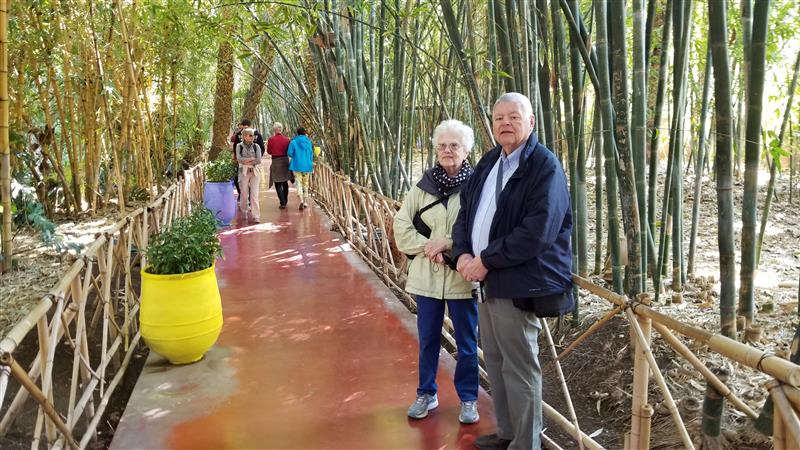
Elaine and Joel under a bamboo canopy
Tom and Joel under a palm canopy
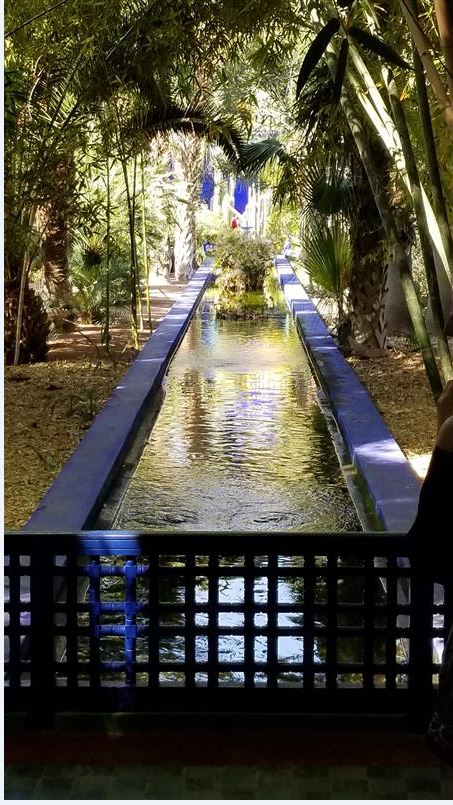
Garden vista
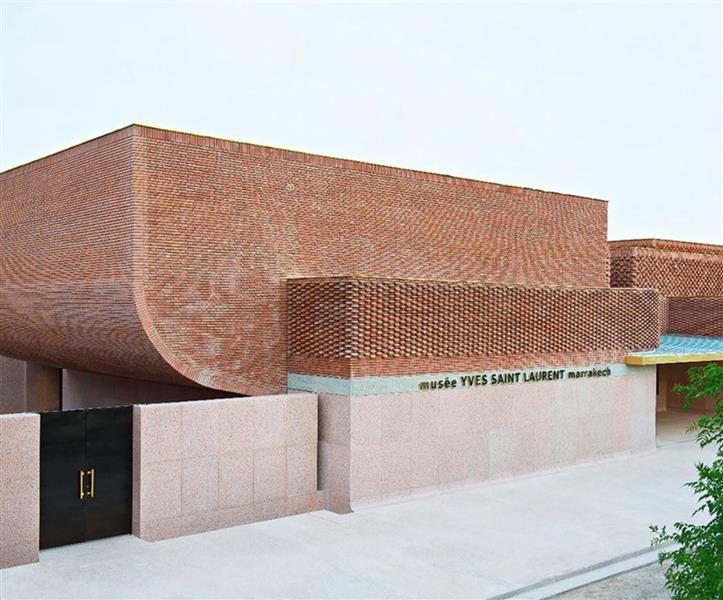
Yves Saint Laurent Museum next to the Majorelle Gardens
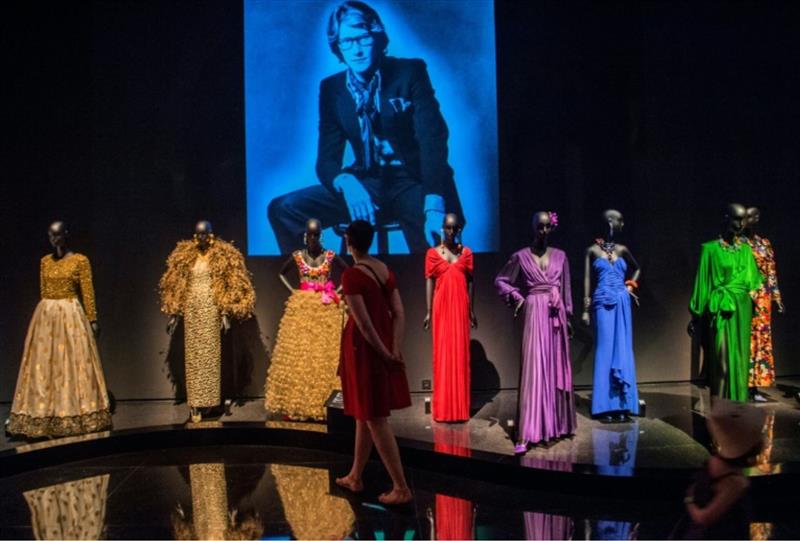
Exhibit inside
Yves Saint Laurent Museum
We left the garden and walked down the block to a new museum of Saint Laurent’s work. It is beautifully done and has a video and a stunning display of his fashions, drawings and jewelry. The Ives Saint Laurent, and the Majorelle Foundations run this complex. Although we faced a long line to get tickets, it was well worth the wait.
After a short rest, the staff where we are staying had a small reception for us. Following that we went to a farewell dinner at a beautiful residence that has been restored and turned into a restaurant.
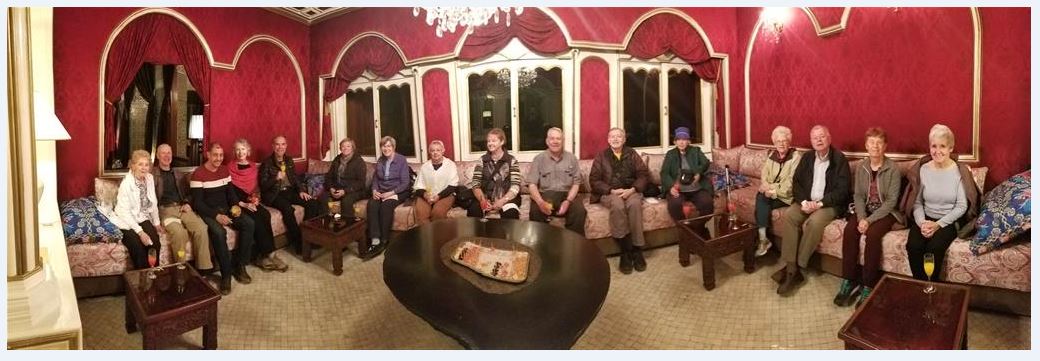
Our whole tour group
at our farewell dinner
So glad you made it to the Majorelle Gardens. Beautiful landscaping and colors. Jon S
Are there many tourists where you have been -- Carol S
Very interesting, thanks for sharing. -- Alameta
Beautiful gardens -- Cheryl
What amazing scenery...and the vegetable market!! wow ..... Sandra B
Please say hi to my mom. I look forward to hearing all about the trip. Have a safe flight home and thanks for keeping in your blog loop. I really enjoyed reliving this wonderful trip! -- Nora
Thanks for the travel guide, love it. -- Sharon S
Hi Tom,
I want to thank you vert much for letting me join you on your wonderful excursion in Morocco. I really enjoyed the many observations and unique experiences you brought to all of
us who followed your trip.
Look forward to seeing you, Dick P
We hopped on our bus for the morning drive from Marrakech to Casablanca (Whitehouse) or "Casa" and the locals refer to it. The largest city in Morocco, it has about 4.4 million inhabitants. Unlike the day we arrived 3 weeks ago in the rain and gray, today was in the bright sunshine.
The city was built largely by the French after the protectorate began in 1912. We read that the film “Casablanca,” filmed in California, went to great pains to paint the city as a mix of Arabs and Europeans when in reality it was mostly European.
Hassan II Mosque in Casablanca, Morocco,
Named for King Mohammed VI's father
Opened in 1993
$800,000 to build
Capacity 25,000 Muslims inside, 80,000 outside
20,000 square meters in size
Third largest after Mecca and Medina, Saudi Arabia
Joel, Elaine and Tom in huge square in front of Hassan II Mosque
Tom taking a stand in front of mosque
All the cities of Morocco have large central mosques, but Casablanca did not. Mosques are built by the government and a campaign was undertaken to raise all the money needed to complete work in 6 years representing the 6 days of creation in Genesis. It is on the Atlantic coast and required the filling in of some land.
Administrative buildings and classrooms as part of the Hassan II Mosque
Elaine near windows in floor looking into the "ablution" area below ... where males wash before prayers
We were required to take off our shoes and we were provided with green bags to put them in and carry with us. The guide said that with 5000 visitors a day, one would never find his shoes again.
Ceiling detail. Chandaliers from Marano, Italy
The is the only mosque we have been able to visit on the trip. Morocco has a law that non-Muslims cannot enter mosques, unlike in other countries. We decided that if we could only go in one, this was the one. It was magnificent. It is open to the public outside of the 5 prayer times in the day.
Carrying our shoes in green bags
Central portion
of Hassan II Mosque
Hassan II Mosque
Column detail in Hassan II Mosque
Ceiling in the middle opens (at the split) to the sky above. Mostly used during Ramadan for air circulation.
Going down in the basement of the Hassan II Mosque
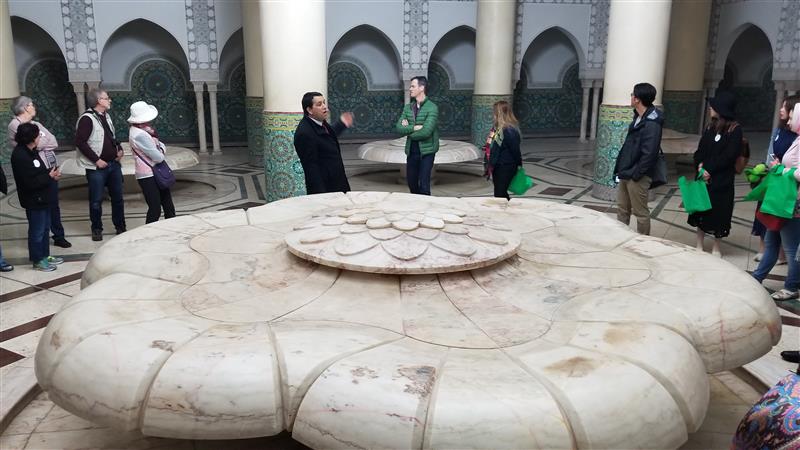
Washing area in basement.
The place for ablutions. Before Muslims go in to pray, they must undergo a ritual washing. There is a certain ritual about washing the face, hands, and feet. Water would come out of this like a fountain in busy times during prayers. Otherwise, there were stations around the walls.
After the mosque, we had a bus tour through the Casablanca beach area and through some of the beautiful neighborhoods. There are wide boulevards and many interesting buildings.
Tonight, we bid adieu to our new best friends. Tomorrow we have a wakeup call at 2:30 to get us started for the airport and our flight home.
Air France, our carrier was on strike yesterday. This morning we opened an Air France e-mail message which said our departing flights had been cancelled. An hour later they said our flights had been reinstated. At the moment we are confirmed on our 7:20 AM flight out of Casablanca. We are confident that all will go well.
The three of us will fly to Paris and from there to Los Angeles culminating in Oakland and Portland. It has been an exceptional trip, and we learned much about a rich and varied land.
Thanks for sharing -- Donna H.
Hi Tom! Thank you for sharing your adventures in Morocco. It was interesting to see and have the sense of the country and people. Thank You!! See you soon! -- Ron M
Thank you for sharing your adventure with me. I’ve never thought of going to Morocco, but you make it so appealing.
Hope you have a safe trip home! -- Carol S
What a lovely trip you have had! Thank you so much for sharing it with us! Love, Nancy D
Dear Tom, thank you very much for letting me be with you in Morocco! I think it must have been a great trip and a very impressive country! I wish you all a good journey back! Lot´s of love and greetings to Elaine and Joel!
-- Love, Ruth W
Thanks for sharing this incredible trip. The architecture simply knocks me out. What intricate detail and art are incorporated into the construction. Oh, and welcome home! See you in a few weeks. Hugs ... Ruth K